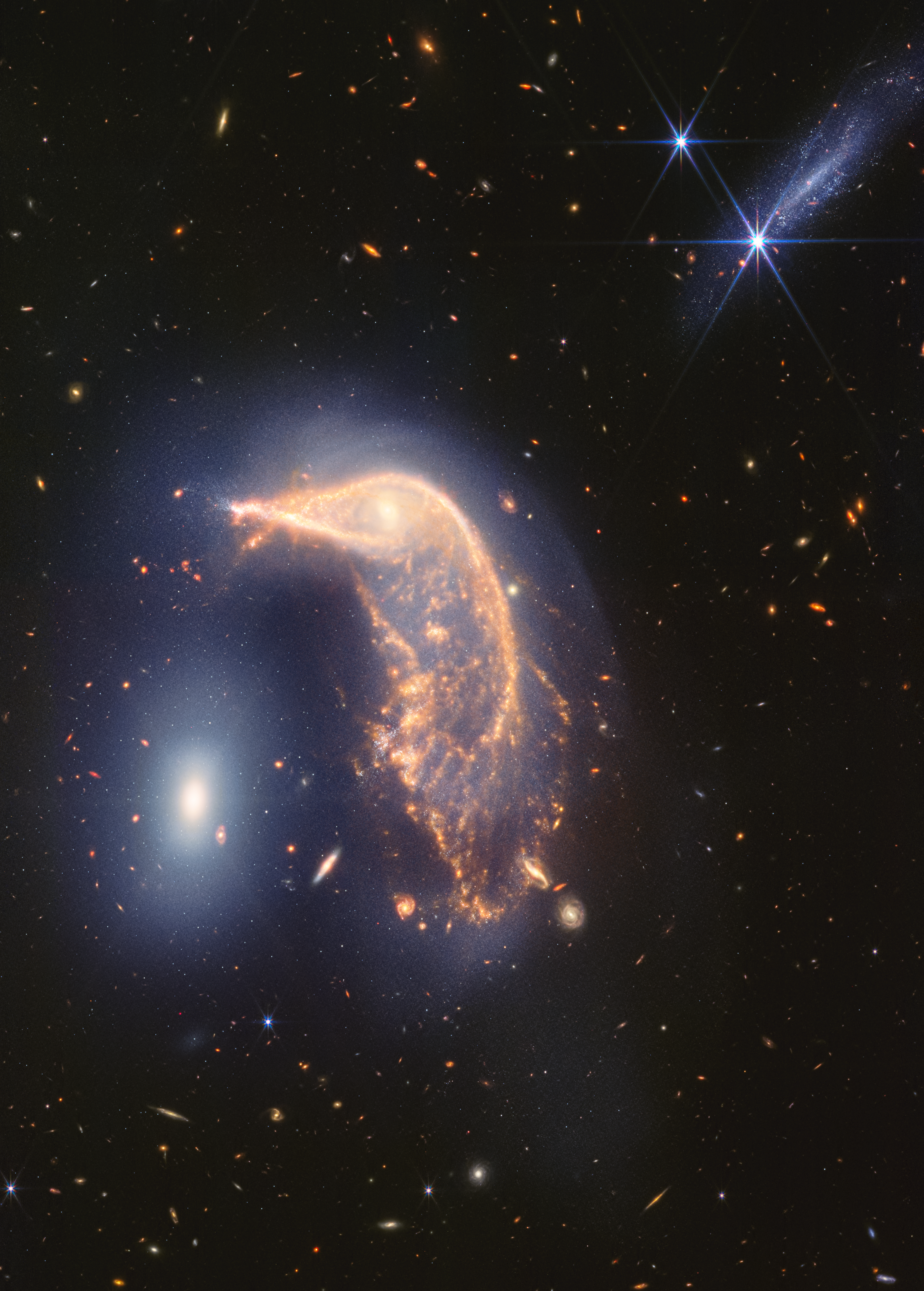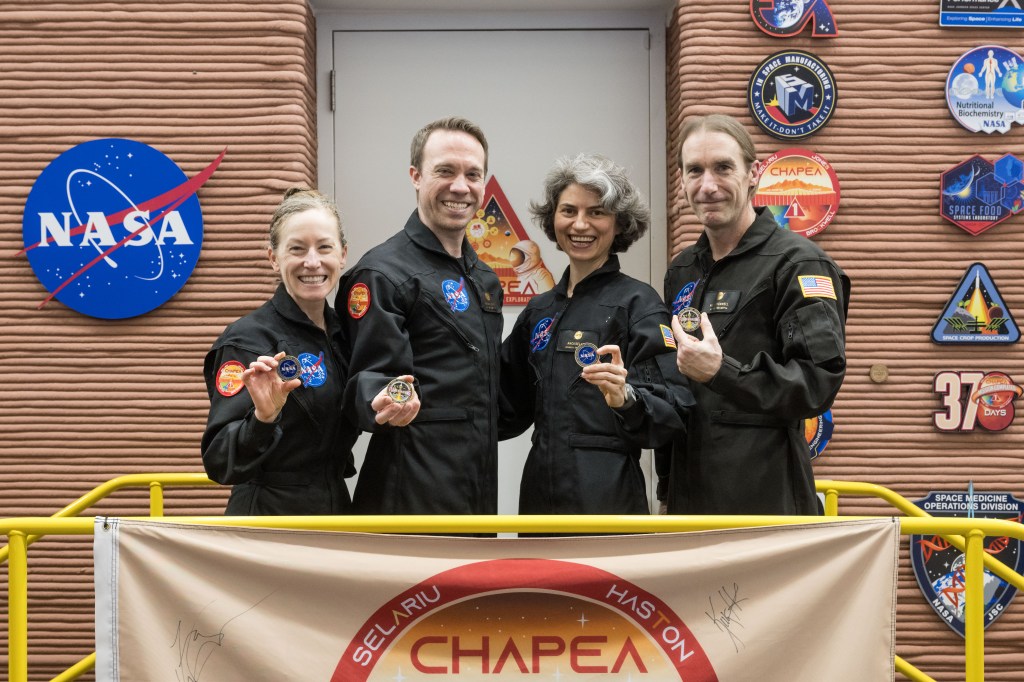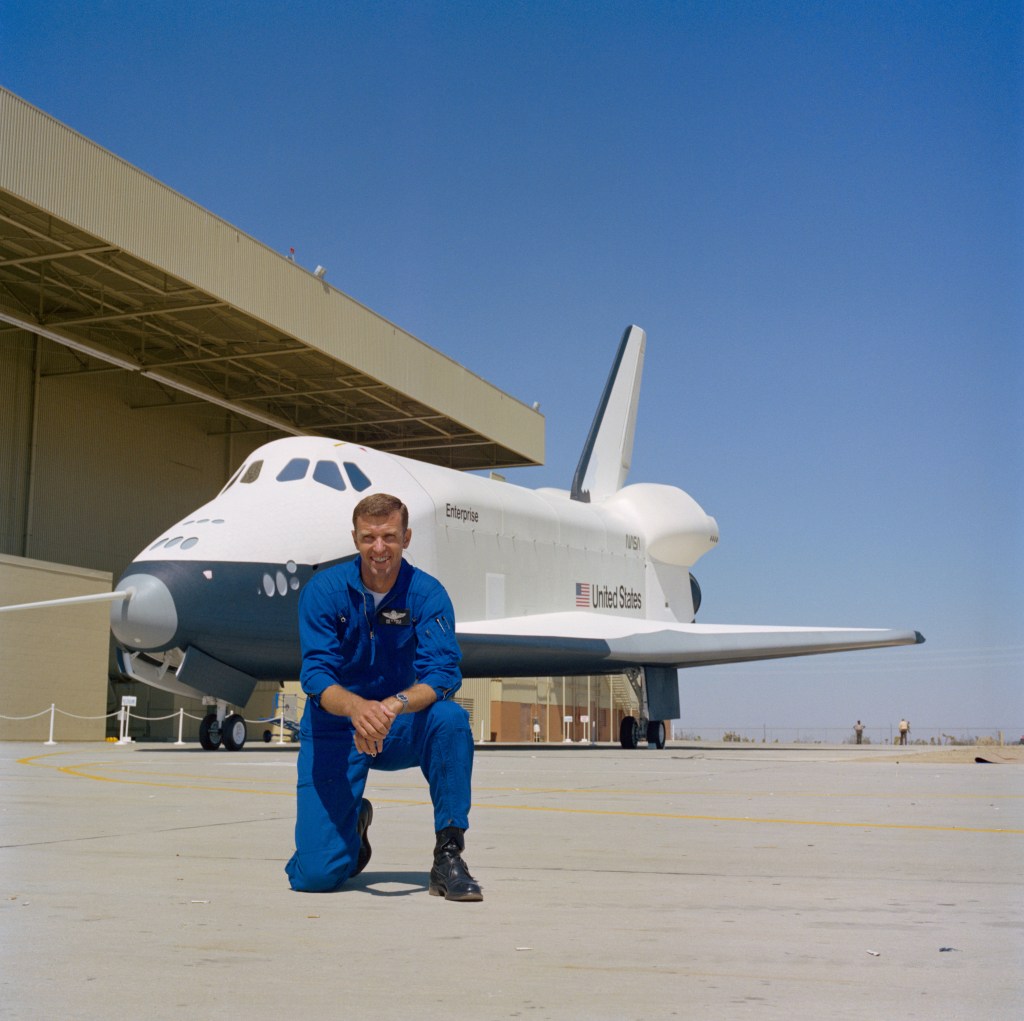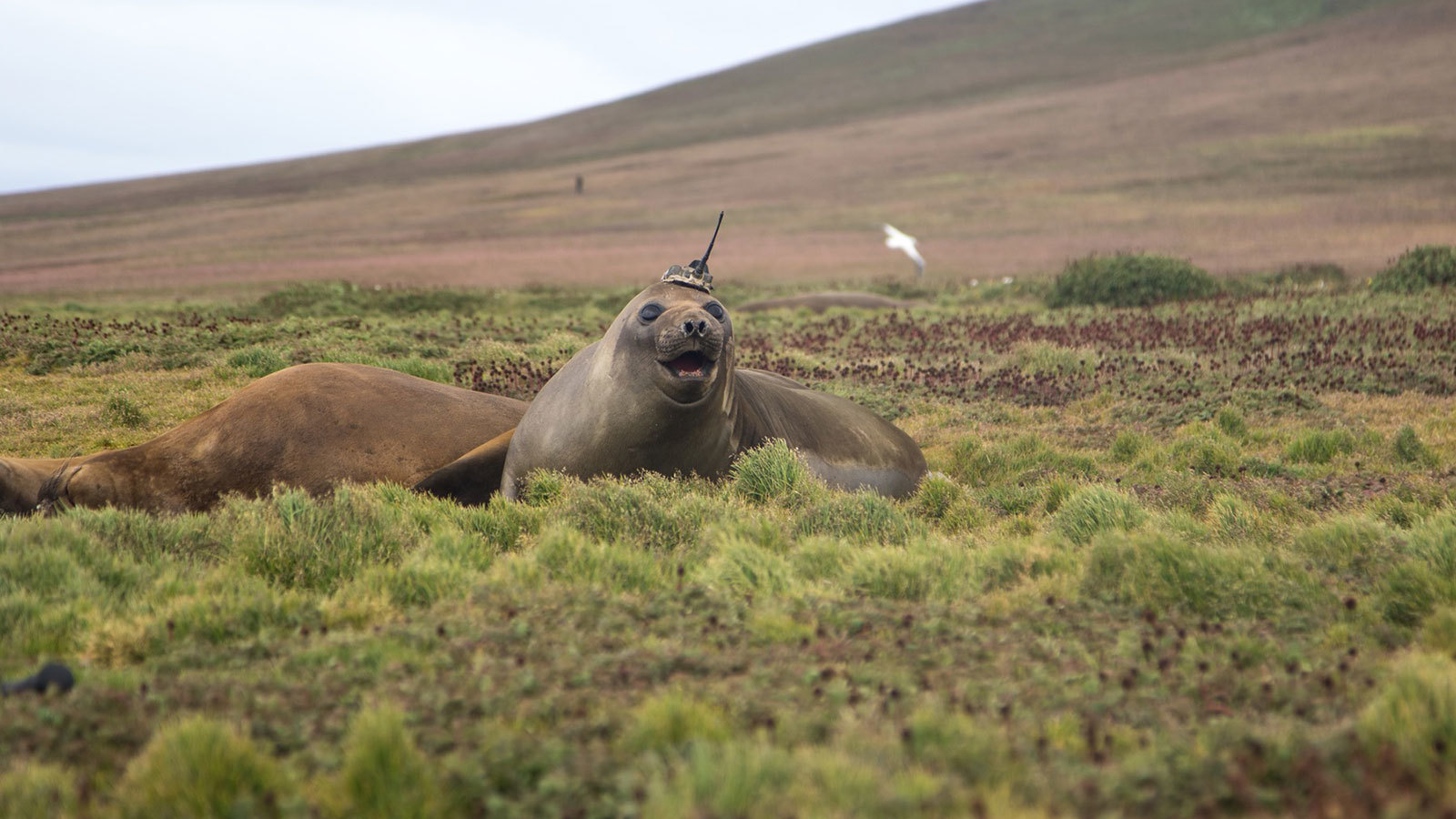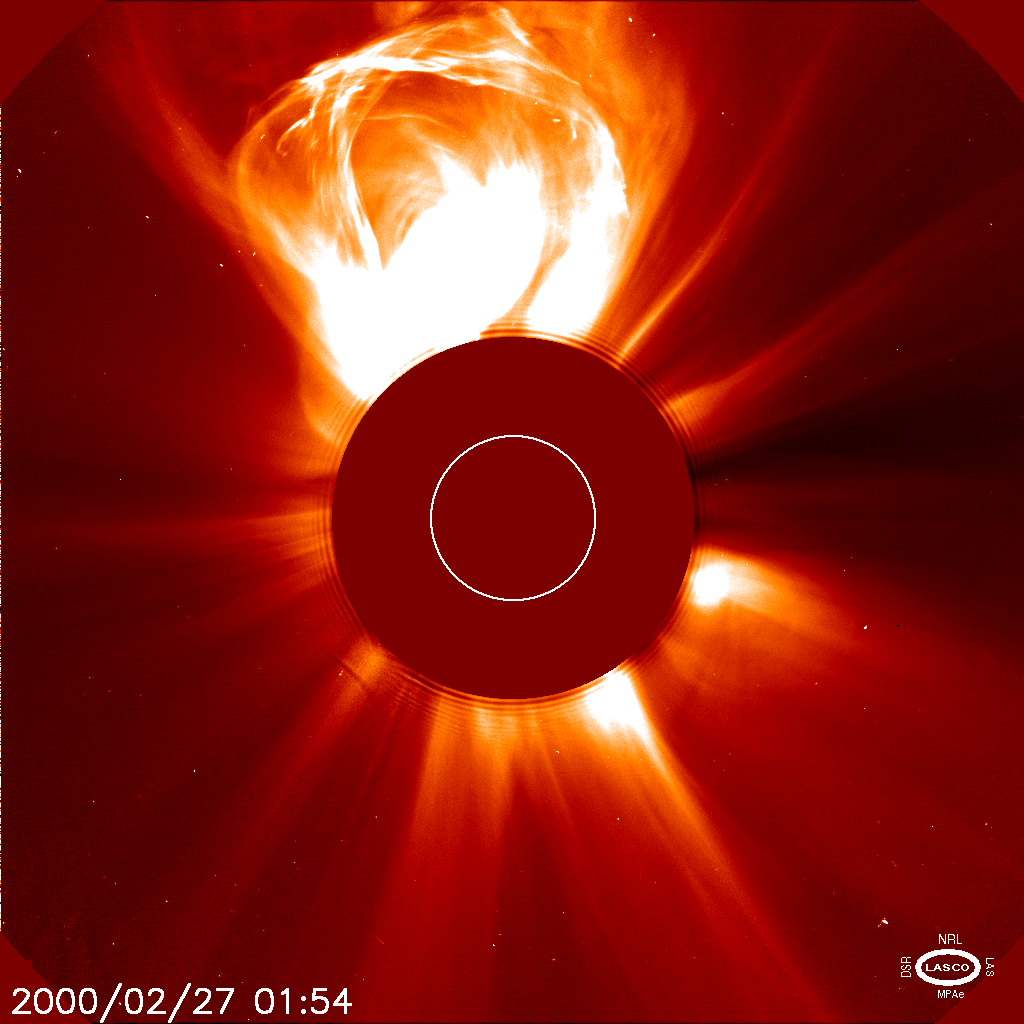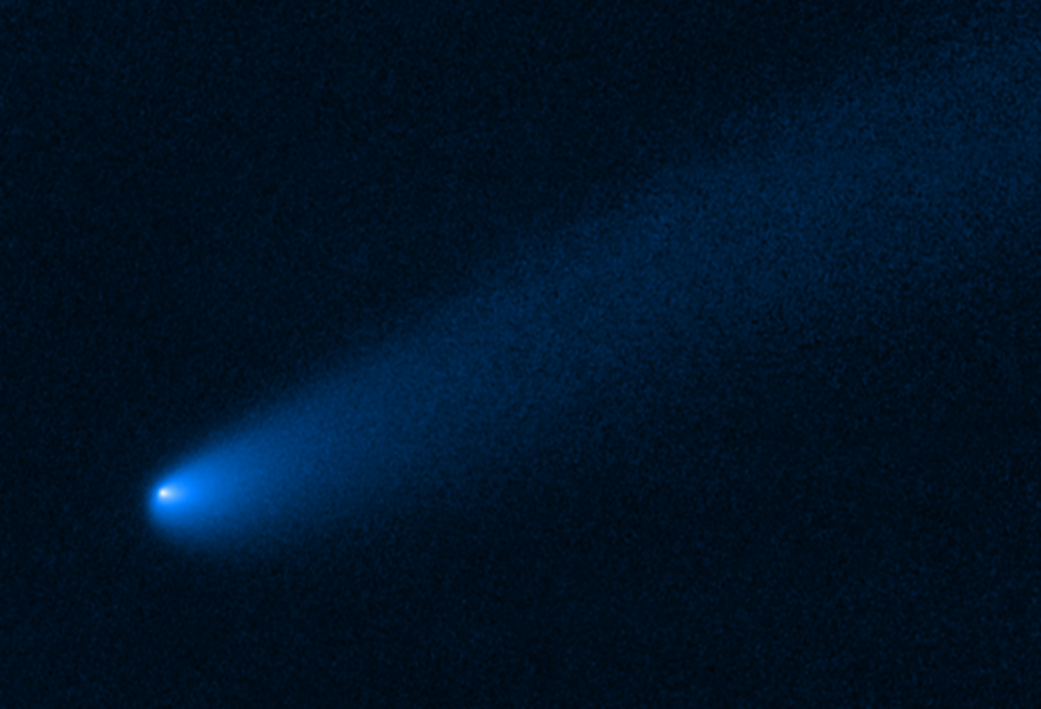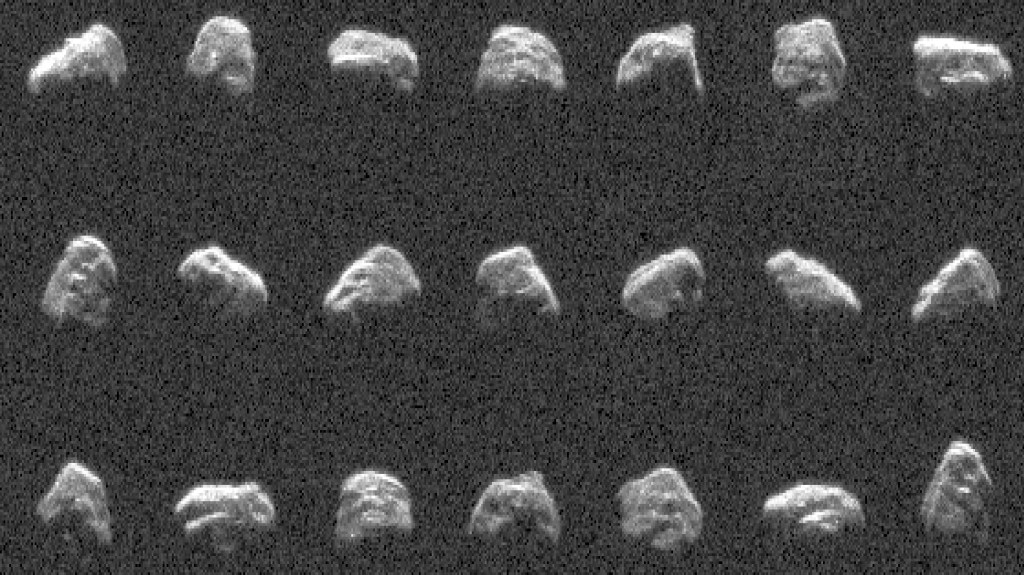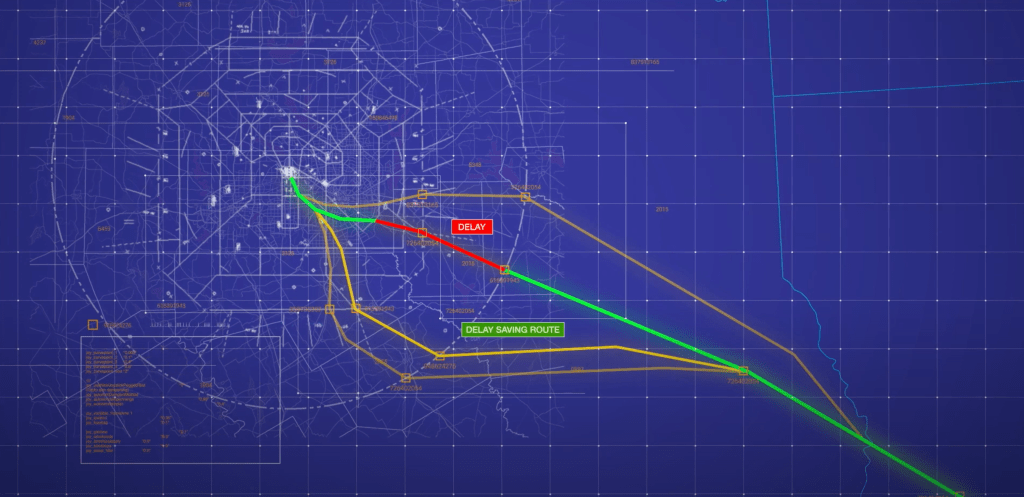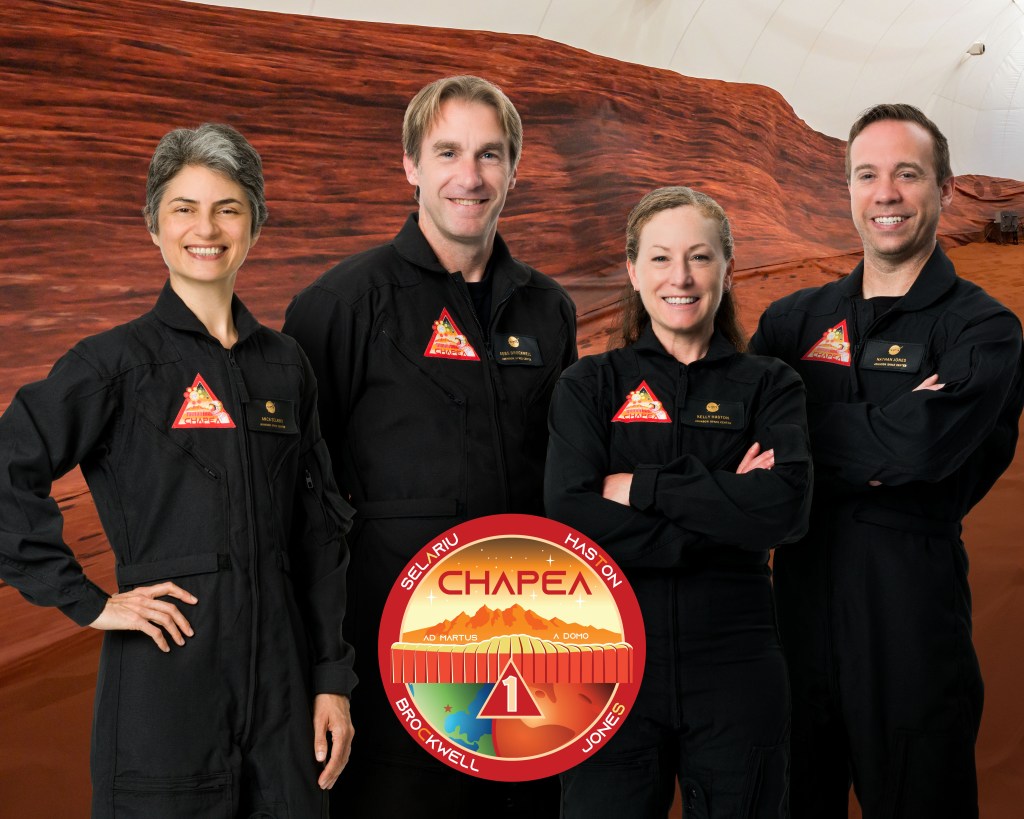“A bird cannot fly with one wing only. Human space flight cannot develop any further without the active participation of women.” – Valentina Tereshkova
“If we want scientists and engineers in the future, we should be cultivating the girls as much as the boys.” – Sally Ride
“International cooperation is very necessary. Chinese have a saying, ‘When all the people collect the wood, you will make a great fire.’” – Liu Yang
As of March 2022, 69 women have flown in space. Of these, 41 have worked the International Space Station as long-duration expedition crewmembers, as visitors on space shuttle assembly flights, or as space flight participants on short-duration Soyuz missions. It is fitting to recognize the significant accomplishments of these women from many nations as well as the pioneering women who preceded them into space. This article cannot recognize all the great contributions by women to make the space station the unique laboratory in space and only strives to capture significant firsts. Many other women contributed to the assembly of the station and the research being conducted aboard on a daily basis. These include not only the astronauts who flew the daring missions but also the many women on the ground who as center directors, managers, flight directors and in many other roles continue the exploration of space. Their achievements will contribute to NASA’s efforts to land the first woman and the first person of color on the Moon and possibly send the first crews to Mars in the coming decades.
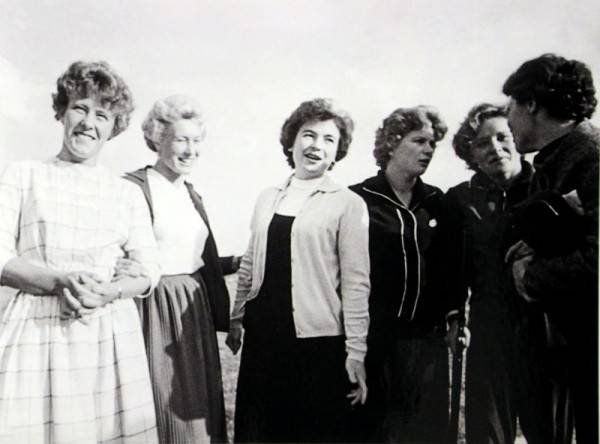
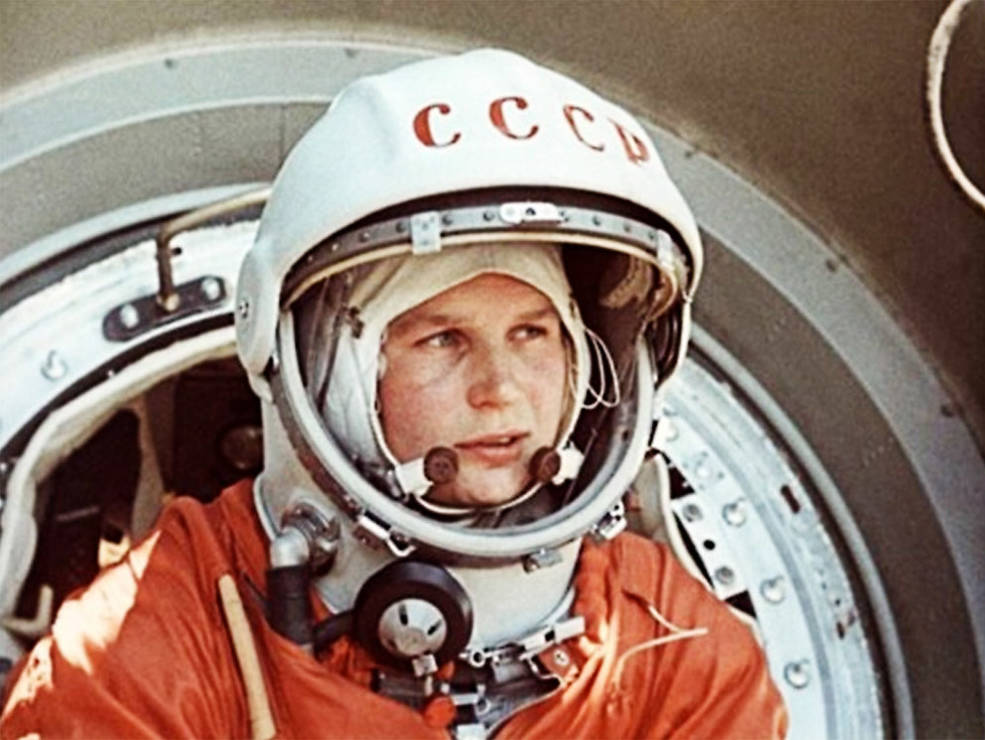
Left: The five women selected for training to be the first woman in space, Soviet
cosmonaut-candidates Valentina L. Ponomareva, left, Tatiana D. Kuznetsova, Irina
B. Soloveva, Valentina V. Tereshkova, and Zhanna D. Yorkina with an unidentified
woman. Right: Tereshkova just before boarding her Vostok 6 capsule for her
historic spaceflight.
Soviet cosmonaut Valentina V. Tereshkova made history on June 16, 1963, when she launched aboard Vostok 6 as the first woman in space. Chosen from a group of five women selected for training, Tereshkova completed a three-day mission and entered the history books. Soviet plans to launch other women cosmonauts in the 1960s never materialized and nearly 20 years passed before another woman flew in space. In January 1978, NASA announced the selection of 35 new astronauts including six women for the space shuttle program. In response, the Soviet Union secretly selected a group of nine women cosmonauts in 1980. On Aug. 19, 1982, one of these women, Svetlana Y. Savitskaya, launched with her two crewmates aboard Soyuz T-7 to spend a week aboard the Salyut-7 space station. The next day they joined the two long-duration resident crewmembers aboard, marking the first time a space station hosted a mixed-gender crew. Ten months later, on June 18, 1983, astronaut Sally K. Ride made history by becoming the first American woman in space, spending seven days aboard the space shuttle Challenger during the STS-7 mission.

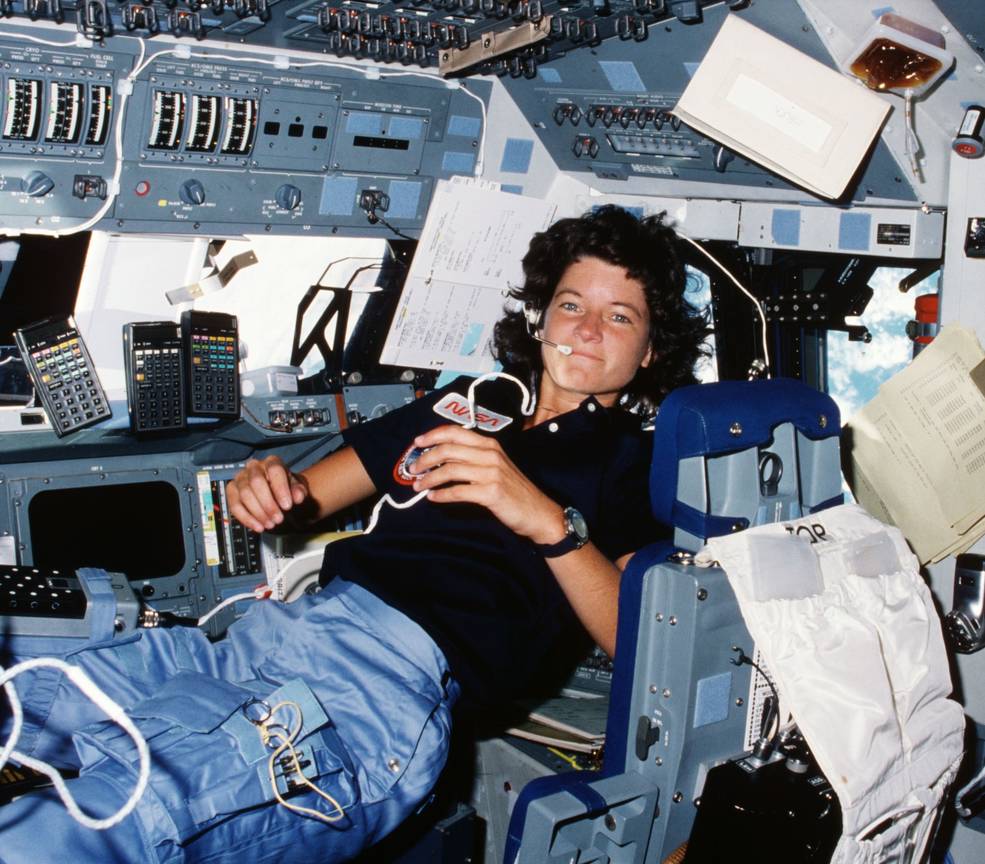
Left: The six women astronauts selected in 1978, Shannon M. Lucid, left, M. Rhea
Seddon, Kathryn D. Sullivan, Judith A. Resnik, Anna L. Fisher, and Sally K. Ride,
pose with an Apollo-era space suit. Right: Ride aboard the space shuttle
Challenger during the STS-7 mission.
Savitskaya made history again on July 25, 1984, as the first woman to participate in a spacewalk during her second flight to Salyut 7. Less than three months later, on Oct. 11, Kathryn D. Sullivan completed the first spacewalk by an American woman from the space shuttle Challenger during the STS-41G mission. With Ride as one of Sullivan’s crewmates, the flight marked the first time that two women flew on the same mission.
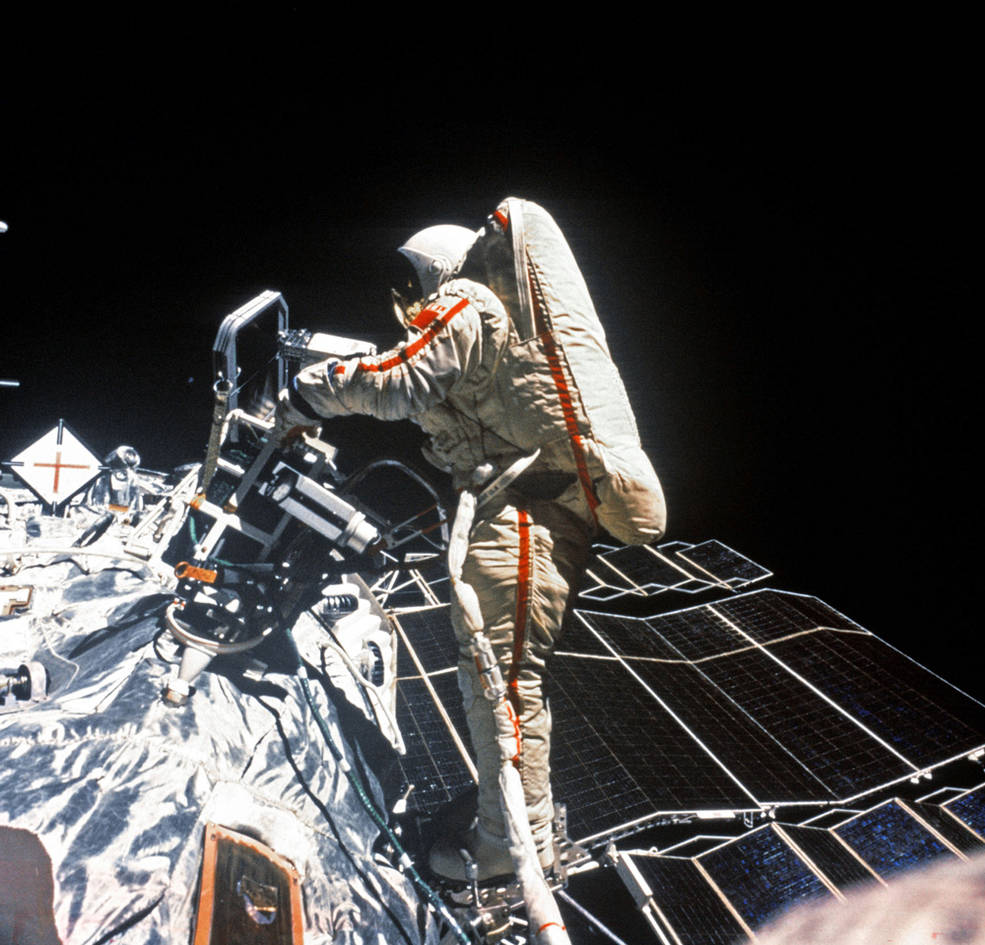

Left: Svetlana Y. Savitskaya during her historic spacewalk outside the Salyut-7
space station. Right: Kathryn D. Sullivan, left, and Sally K. Ride aboard space
shuttle Challenger during the STS-41G mission.
Helen P. Sharman has the distinction of being not only the first person from the United Kingdom in space but also the first woman to visit the Russian space station Mir. During her eight-day privately funded Juno mission in May 1991, Sharman conducted a series of life sciences experiments and talked to British schoolchildren. The next month marked the first time that three women – M. Rhea Seddon, Tamara E. Jernigan, and Millie E. Hughes-Fulford – were in space at the same time during the STS-40 Spacelab Life Sciences 1 mission.


Left: Helen P. Sharman, the United Kingdom’s first astronaut, aboard the Russian
space station Mir in 1991. Right: The first time three women – Tamara E. Jernigan,
back row middle, M. Rhea Seddon, and Millie R. Hughes-Fulford – were in space
during the STS-40 mission in 1991.
The honor of the first woman to complete a long-duration mission in space belongs to Russian cosmonaut Elena V. Kondakova. She launched aboard Soyuz TM20 on Oct. 3, 1994, and spent 169 days aboard the space station Mir as part of Expedition 17, returning to Earth on March 22, 1995. The first American woman to complete a long-duration mission, Shannon W. Lucid, launched on March 22, 1996, aboard space shuttle Atlantis. The second astronaut to fly as part of the Shuttle-Mir Program, she spent 188 days aboard Mir as part of Expeditions 21 and 22, returning to Earth with STS-79 on Sep. 26.
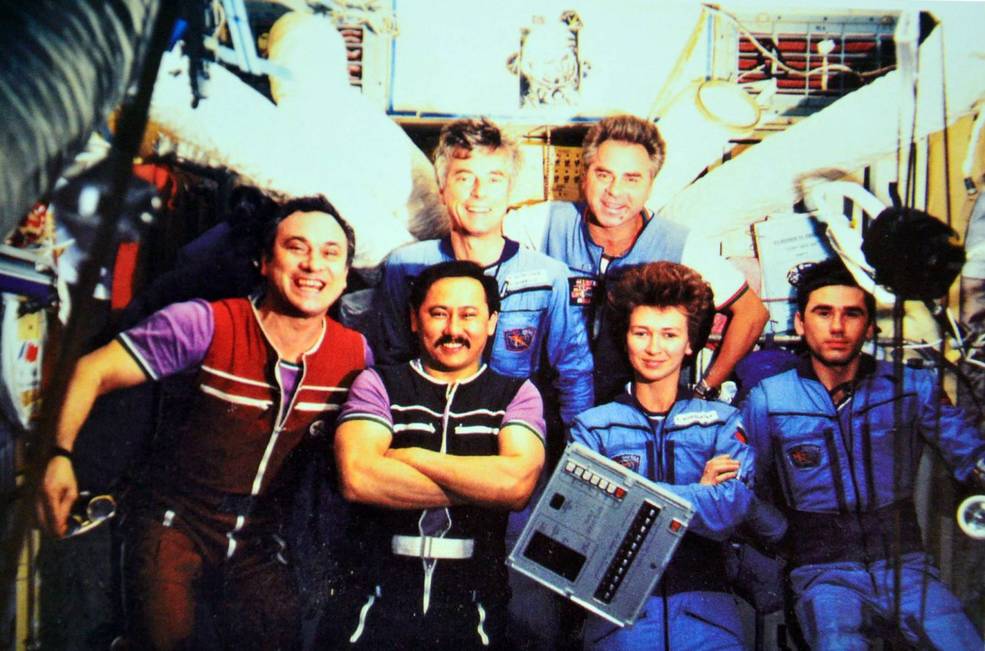
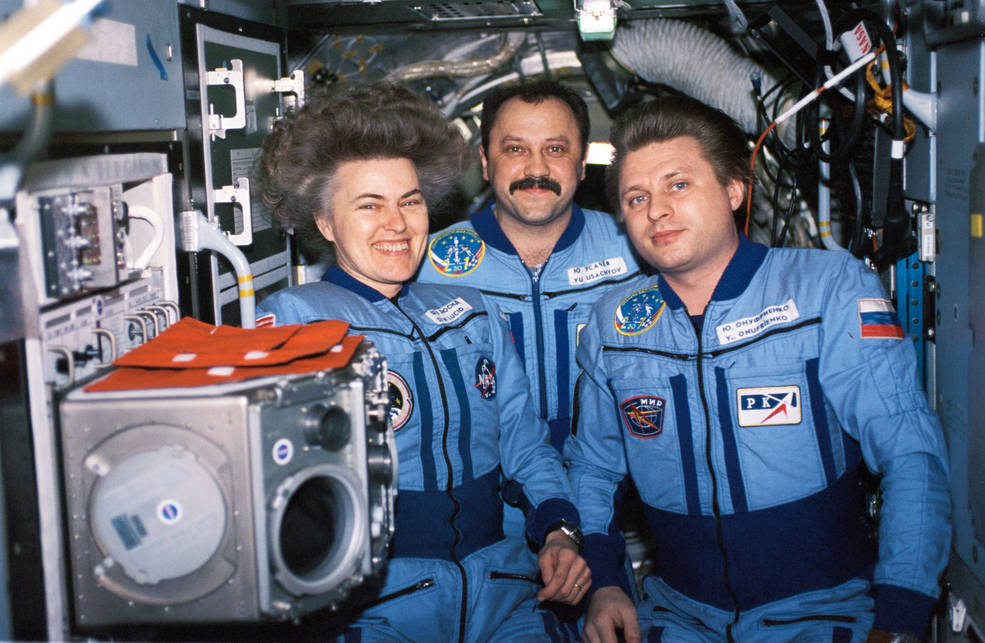
Left: Elena V. Kondakova, second from right, aboard Mir during the handover
between Expedition 16 and 17 in 1994. Right: Shannon W. Lucid, left, with
her Mir Expedition 21 crewmates in 1996.
With Lucid still onboard Mir, the August 1996 mission of Claudie André-Deshays, France’s first woman astronaut visiting the station during her Cassiopée research mission, marked the first time that two women lived aboard any space station. After marrying fellow French astronaut and Mir veteran Jean-Pierre Haigneré, she returned to space in October 2001, this time during her eight-day Andromède mission to the International Space Station, becoming the first woman to stay aboard two space stations.
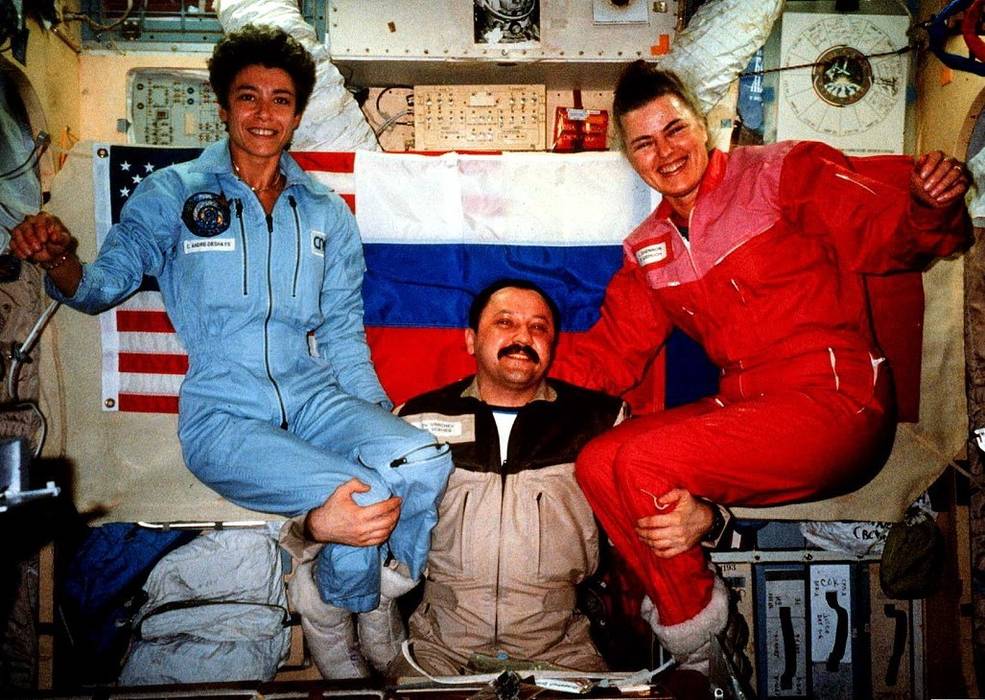
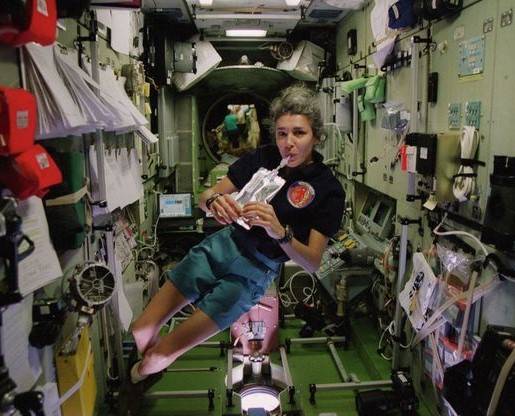
Left: Claudie André-Deshays, left, France’s first female astronaut, with Russian
cosmonaut Yuri V. Usachev and American astronaut Shannon M. Lucid aboard
Mir in 1996. Right: Claudie (André-Deshays) Haigneré in the Zvezda
Service Module of the International Space Station in 2001.
As on-orbit assembly of the International Space Station commenced in 1998, female astronauts were involved from the very beginning. As the first woman to reach the new facility, Nancy J. Currie participated in the first assembly mission, STS-88 in December 1998, using the shuttle’s robotic arm to precisely join the American Unity Node 1 module to the Russian-built Zarya module, launched three weeks earlier.
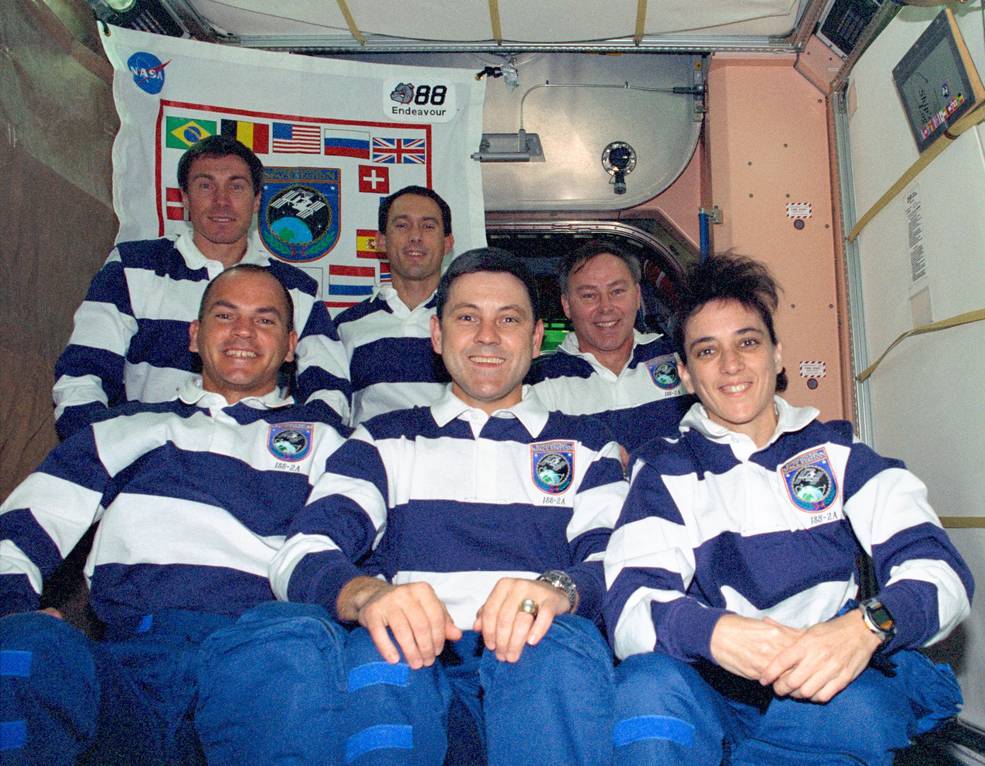
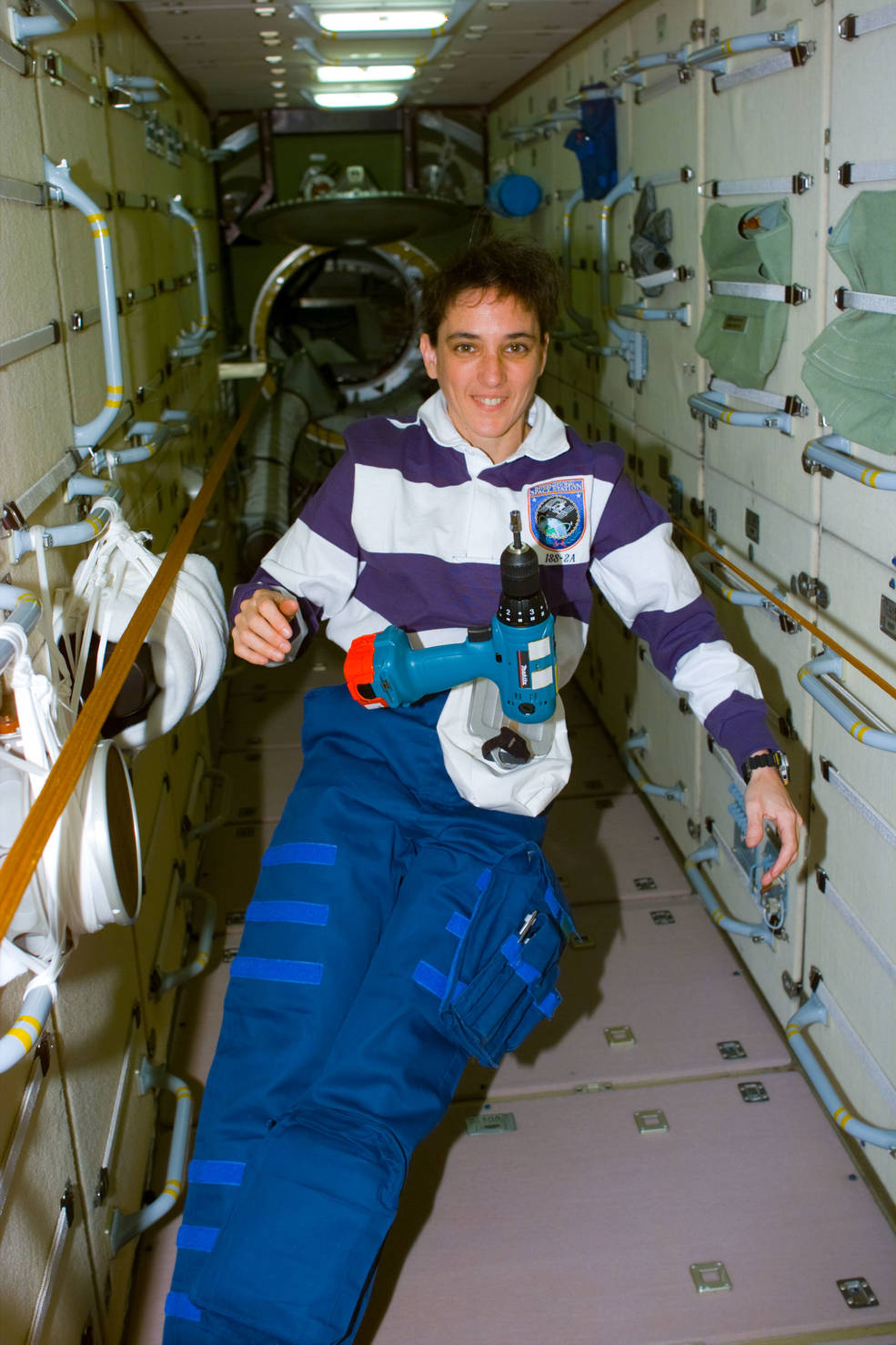
Left: Nancy J. Currie, front row right, the first woman to reach the International
Space Station, with her STS-88 crewmates in 1998. Right: Currie at work
in the Zarya module.
The second space station assembly mission, STS-96 in May 1999, included three women on the crew – Jernigan, Ellen L. Ochoa, and Julie Payette. Jernigan became the first woman to participate in a spacewalk at the space station to install crane equipment for future assembly tasks, with Ochoa as the robotic arm operator. Payette became the first Canadian of any gender to visit the space station and became the first Canadian to return to the space station during STS-127 in 2009.
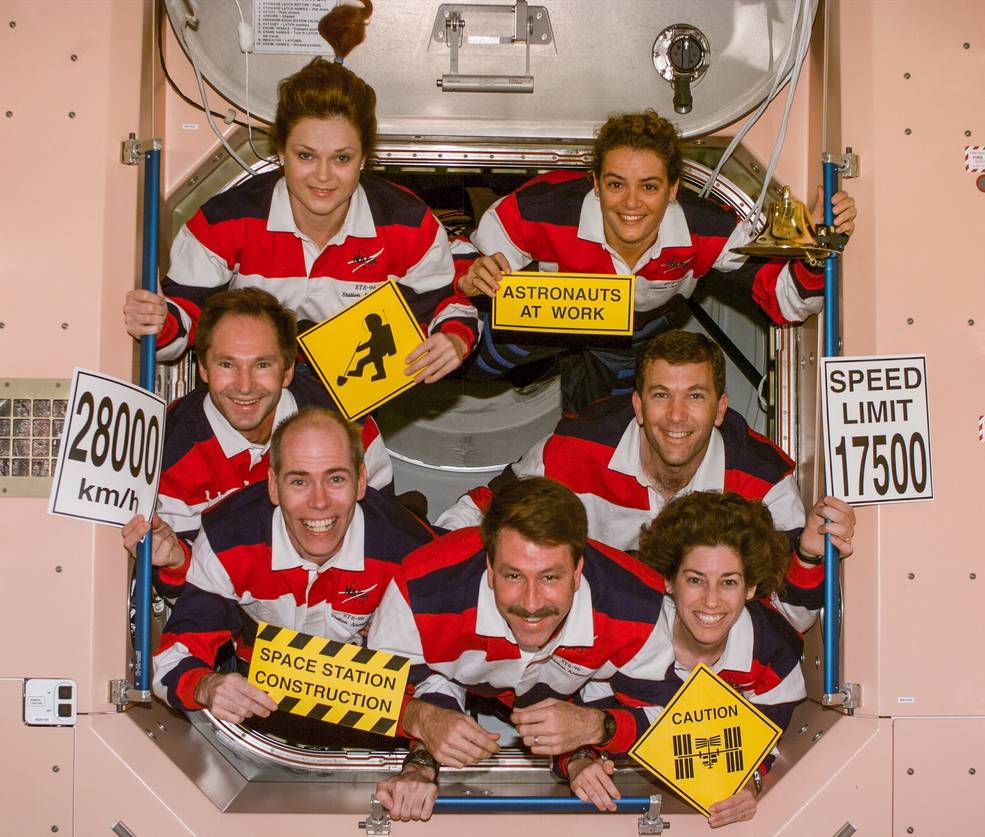
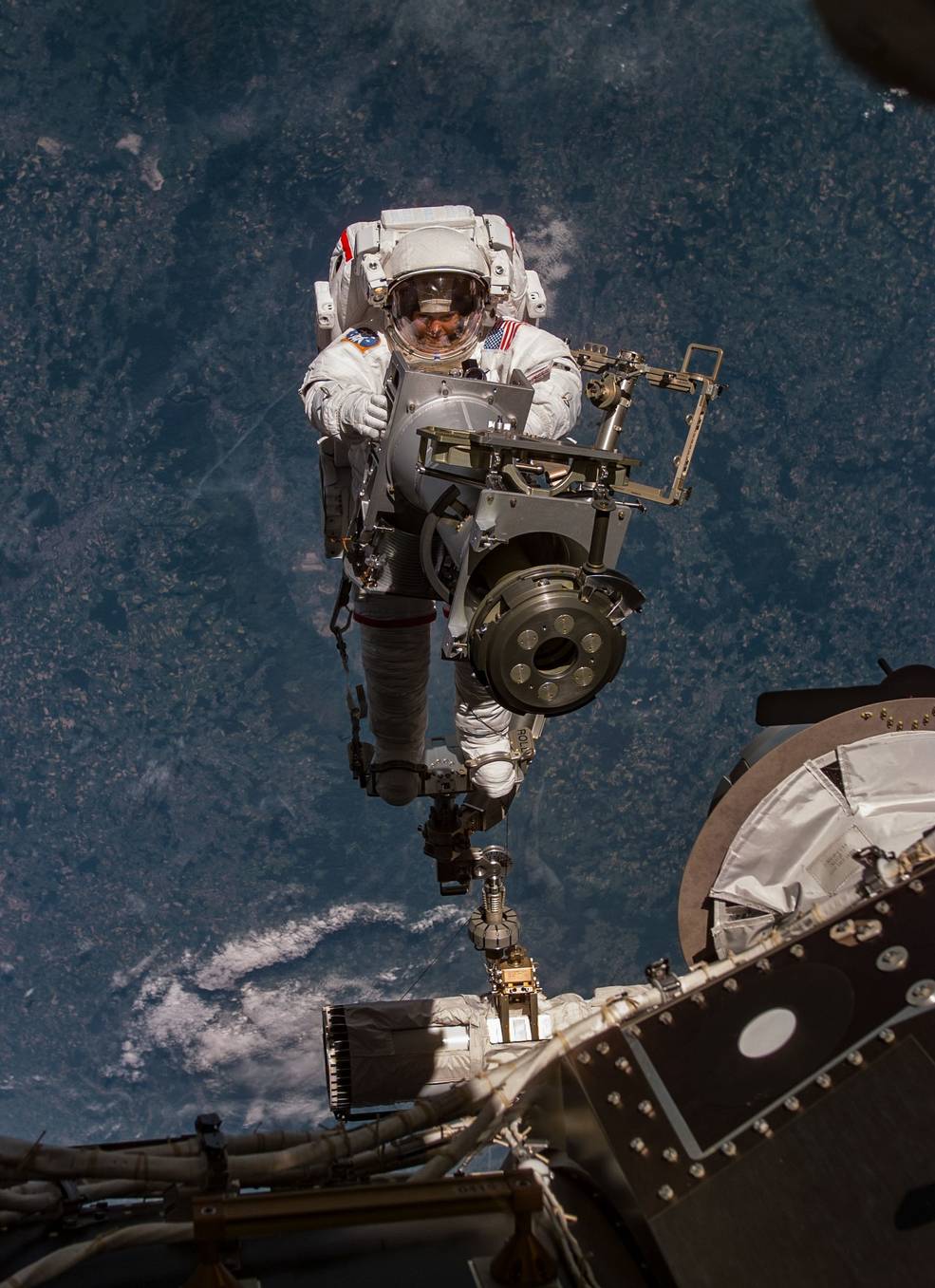
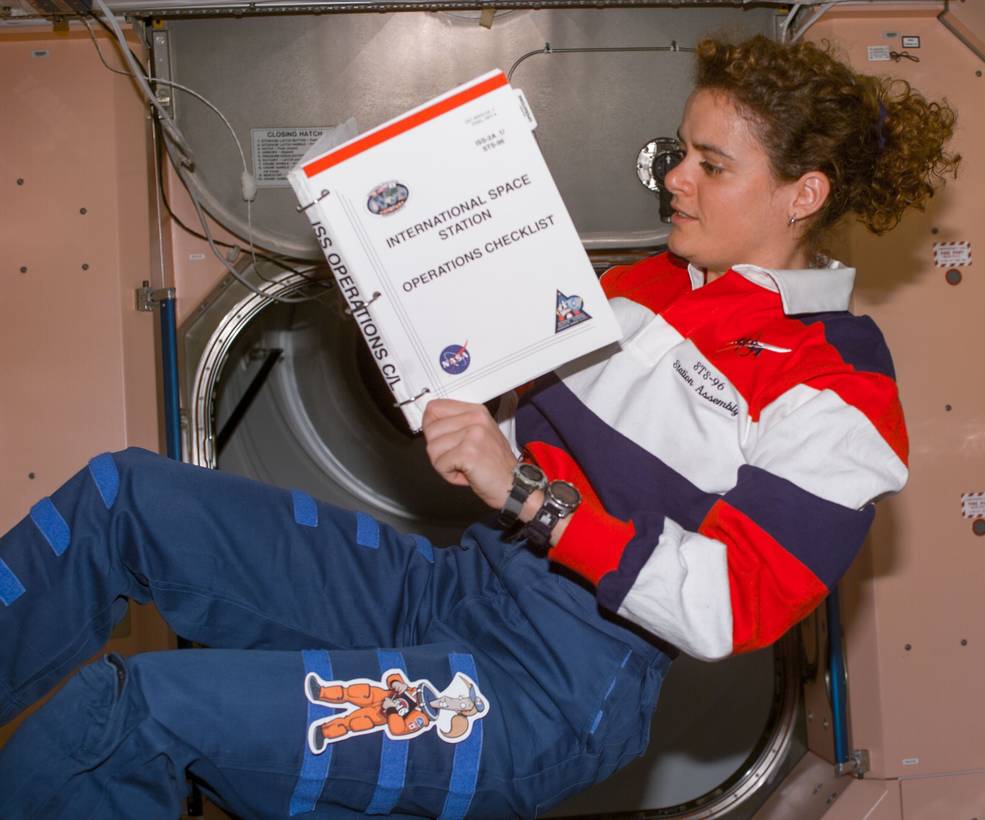
Left: In 1999, STS-96 crew in the Unity Node 1 module, with Tamara E. Jernigan and Julie Payette in
the top row and Ellen L. Ochoa at bottom right. Middle: Jernigan during the STS-96 spacewalk.
Right: Payette in the Unity Node 1 module.
Astronaut Pamela A. Melroy was the first woman to serve as a pilot on a shuttle flight to the space station, STS-92 in October 2000, the mission that added the Z1 truss, control moment gyros, and a Pressurized Mating Adaptor to the developing station. She returned to the station as pilot of STS-112 in October 2002 and as commander of STS-120 in October 2007. Astronaut Susan J. Helms holds several distinctions for women. As a member of Expedition 2, she became the first woman to complete a long-duration mission on the space station, a 167-day flight between March and August of 2001. She had previously flown to the station during STS-101, making her the first woman to visit the facility twice. Helms was the first woman with a military background to visit the station, having graduated in the U.S. Air Force Academy’s first woman-inclusive class of 1980. She co-holds the record for the longest spacewalk to date, 8 hours 56 minutes, completed with her Expedition 2 crewmate James S. Voss.
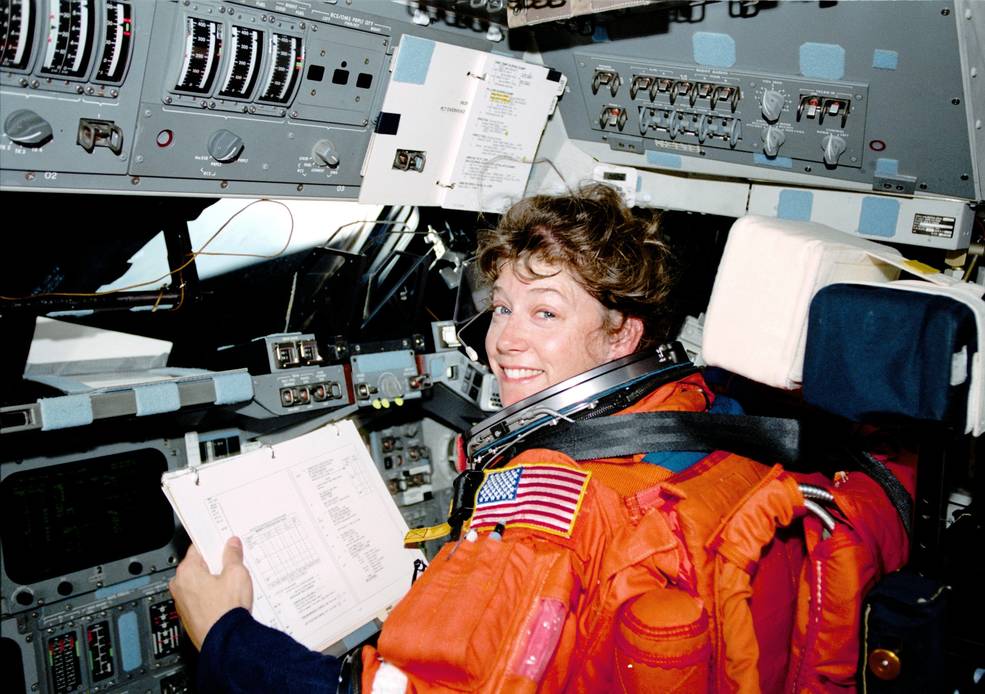
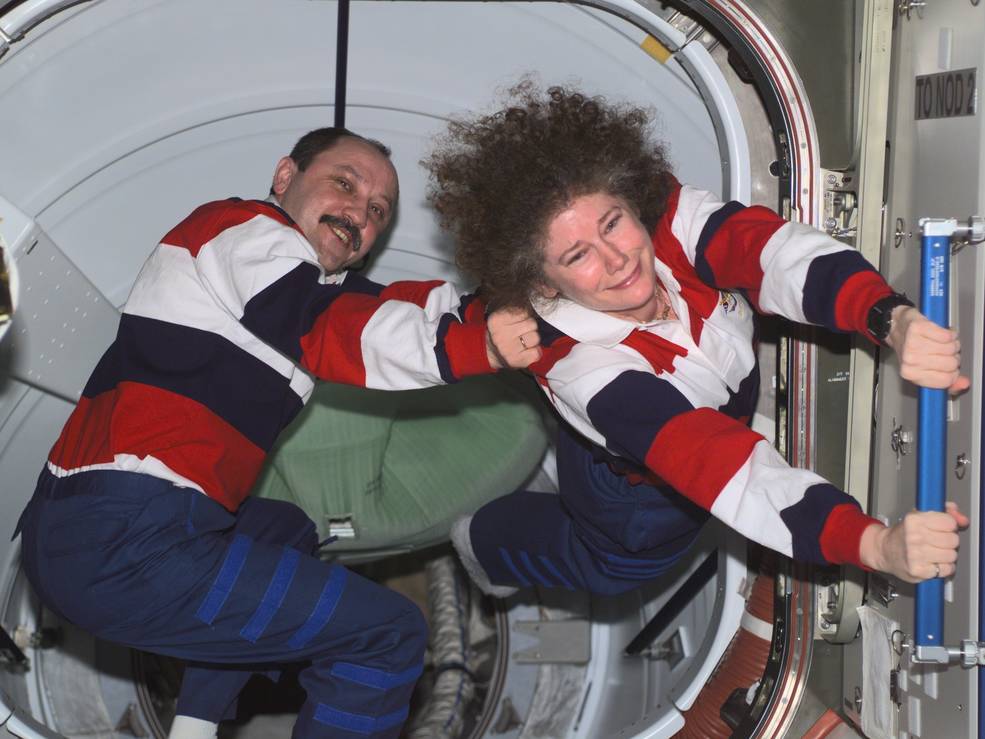
Left: STS-92 Pilot Pamela A. Melroy shortly after reaching orbit in 2000. Right: Expedition
2 Commander Yuri V. Usachev, left, coaxing a reluctant Flight Engineer Susan J. Helms
to leave the International Space Station at the end of their mission in 2001.
Eileen M. Collins had already made history twice before, first in 1995 as the first female pilot of a space shuttle mission and again in 1999 as the first woman shuttle commander. In 2005, Collins became the first woman to command a shuttle mission to the space station, the Return to Flight STS-114 mission, the first after the Columbia accident two years previously. Heidemarie M. “Heidi” Stefanyshyn-Piper was the first woman to conduct a spacewalk from the station’s Quest Joint Airlock Module on Sep. 12, 2006, during the STS-115 mission that installed the P3/P4 truss segment on the station.
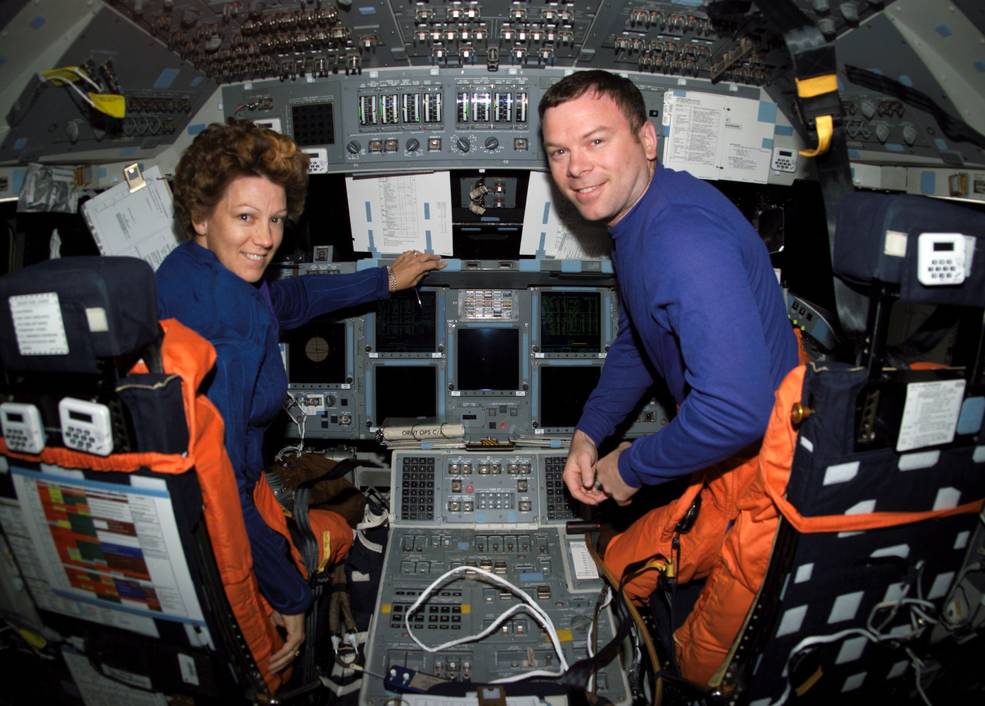
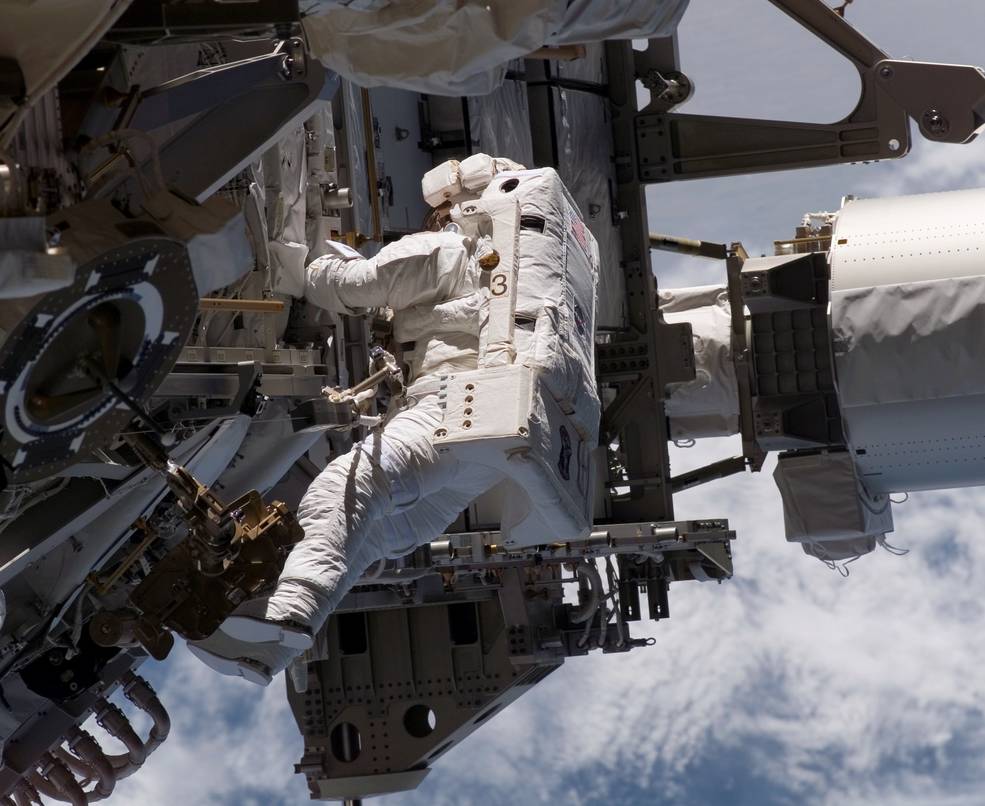
Left: In 2005, STS-114 Commander Eileen M. Collins, left, with Pilot James M. “Vegas”
Kelly on the flight deck of Discovery. Right: Heidemarie M. “Heidi” Stefanyshyn-Piper
working on the P3/P4 truss segment during an STS-115 spacewalk in 2006.
Peggy A. Whitson became the first female commander of the space station during Expedition 16 in 2007, her second long-duration mission to the orbiting lab. Expedition 16 was notable for the addition to the station of the Harmony Node 2 module, the European Space Agency’s (ESA) Columbus research module, the first of the Japan Aerospace Exploration Agency (JAXA) elements, and the arrival of the first of ESA’s Automated Transfer Vehicle cargo resupply vehicles. As noted above, Melroy commanded STS-120, the October 2007 mission that brought Columbus to the station, marking the first and only time that commanders of both the space station and the visiting space shuttle were women. In 2017, during Expedition 51 Whitson became the first woman to command the station for a second time. As of March 2022, Whitson holds the record for most cumulative spaceflight time for a woman as well as for any American astronaut. Over the course of three long-duration missions aboard the space station, she spent a total of 665 days or about 1.8 years in space. She also holds the record for the most spacewalk time for a woman – over her three missions, she spent 60 hours, 21 minutes outside the station over the course of 10 spacewalks.
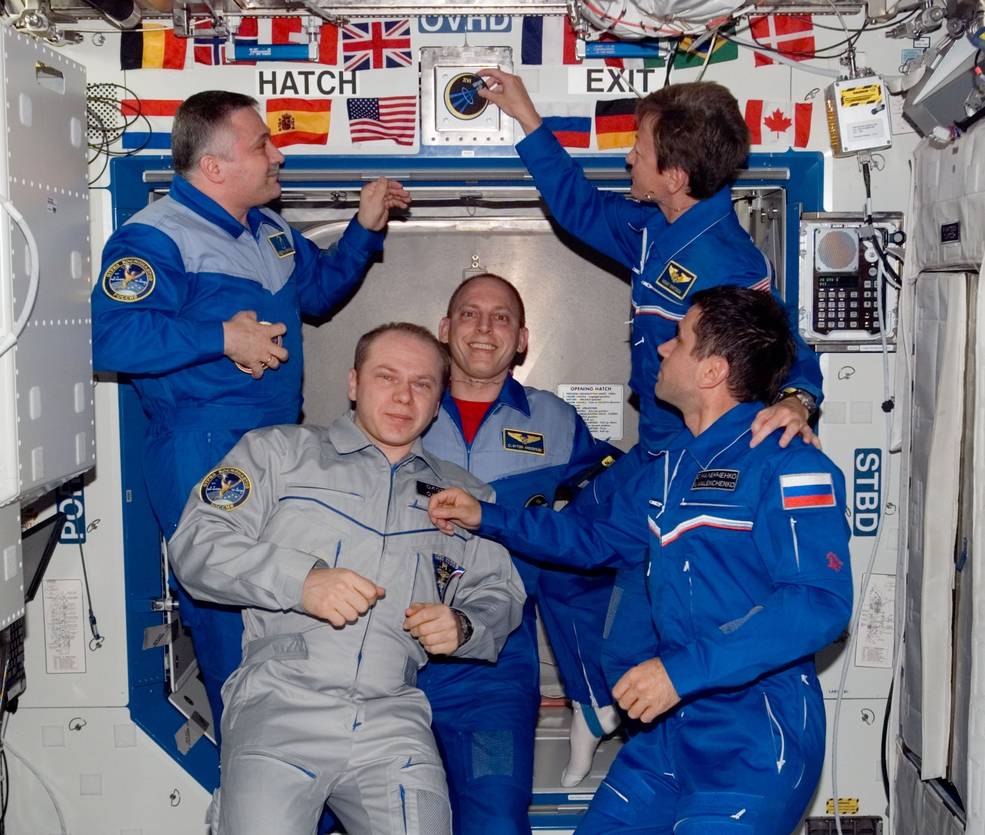
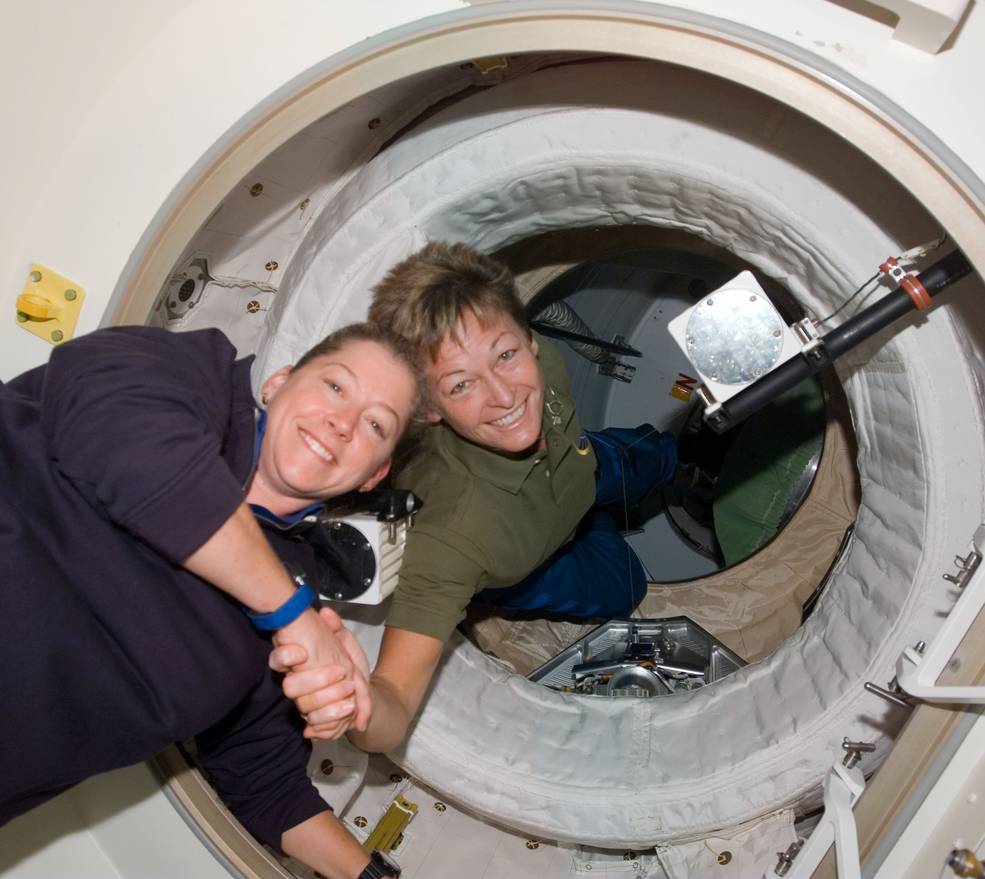
Left: During the change of command ceremony, Expedition 16 Commander
Peggy A. Whitson, top right, hangs the crew’s patch in the Destiny module.
Right: STS-120 Commander Pamela A. Melroy, left, and Expedition 16
Commander Whitson meet at the hatch between the two vehicles.
The first, and so far only, time four women were aboard the space station at one time occurred between May 16 and 23, 2010. Expedition 23 Flight Engineer Tracy E. Caldwell Dyson had been living and working aboard since April when STS-131 arrived, with Dorothy M. “Dottie” Metcalf-Lindenburger, Stephanie D. Wilson, and Naoko Yamazaki of JAXA as part of the shuttle crew. The mission brought four new research facilities to the station. Three weeks after the shuttle’s departure, Caldwell Dyson and her crewmates welcomed a new trio of long-duration crew members including Shannon Walker, making Expedition 24 the first to include two women. The next two-woman expedition took place between November 2014 and March 2015 – Expedition 42 included Elena O. Serova, the first Russian woman to make a long-duration flight aboard the space station, and Samantha Cristoforetti from Italy, the first female ESA astronaut on a long-duration mission.
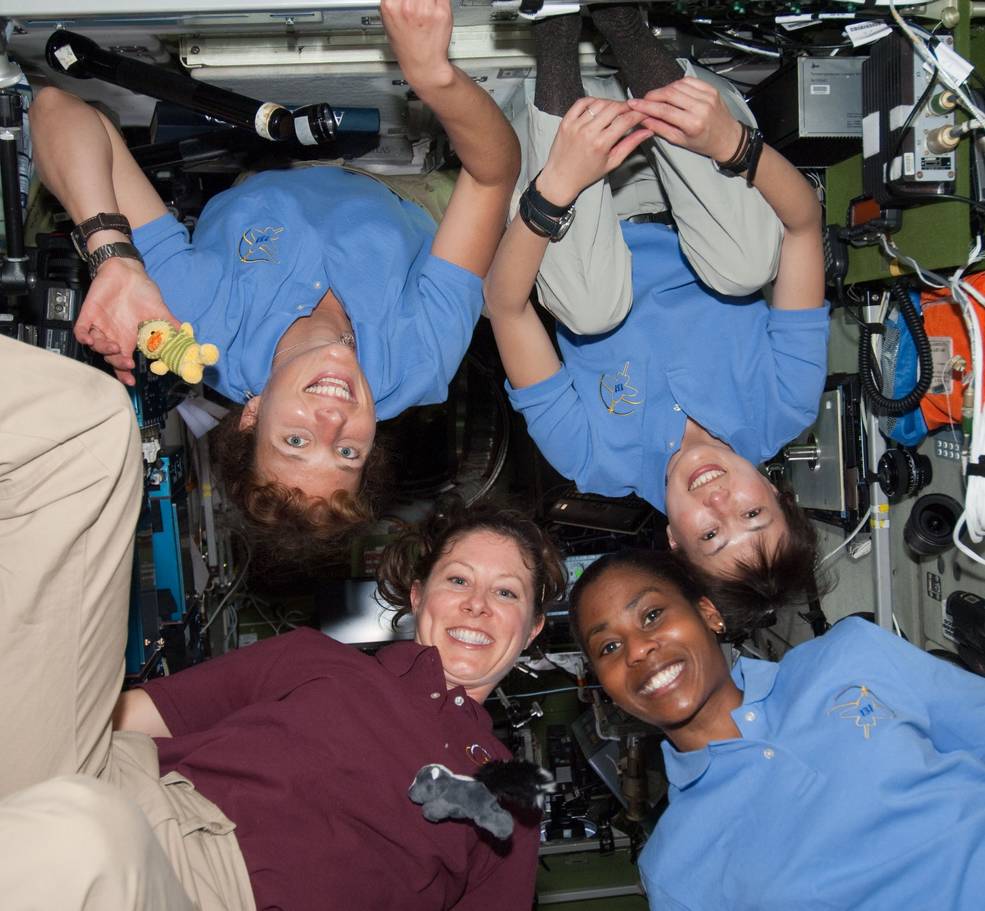
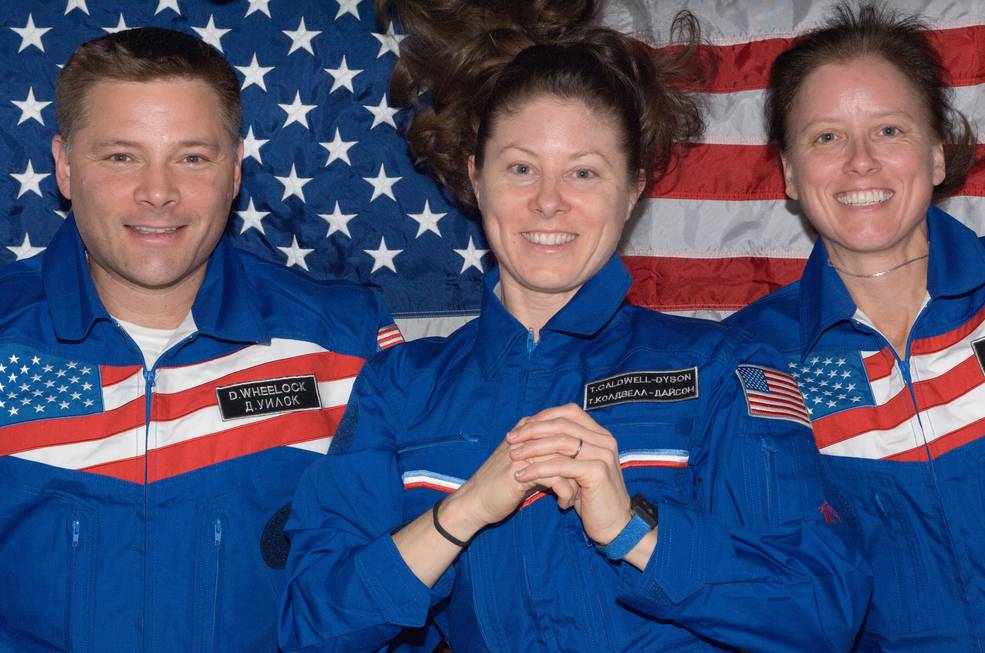
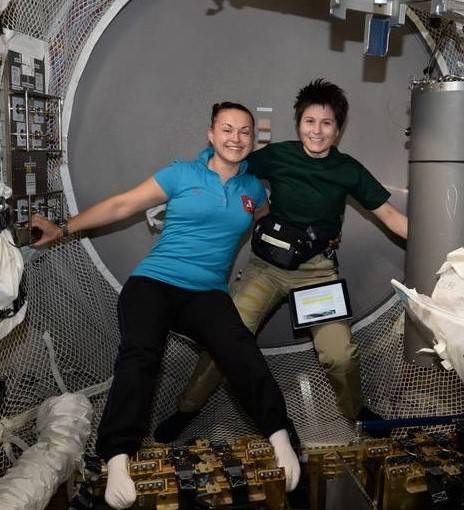
Left: Four women aboard the International Space Station – Dorothy M. Metcalf-Lindenburger, top left,
Naoko Yamazaki of the Japan Aerospace Exploration Agency, Stephanie D. Wilson, and Tracy E.
Caldwell Dyson. Middle: Caldwell Dyson, middle, and Shannon Walker with their Expedition 24
crewmate Douglas H. “Wheels” Wheelock, left. Right: Elena O. Serova, left, of Roscomos and
European Space Agency astronaut Samantha Cristoforetti in the Automated Transfer Vehicle-5
Georges Lemaître cargo vehicle during Expedition 42.
Expeditions including two women have recently become more common. During Expedition 57, Serena M. Auñón-Chancellor and Anne C. McClain overlapped by about three weeks in December 2018. Between March and June 2019, McClain and Christina H. Koch were aboard as part of Expedition 59, and Jessica U. Meir joined Koch in September of that year during Expedition 61. Koch returned to Earth in February 2020, completing a flight of 329 days, the longest single mission to date by a woman.
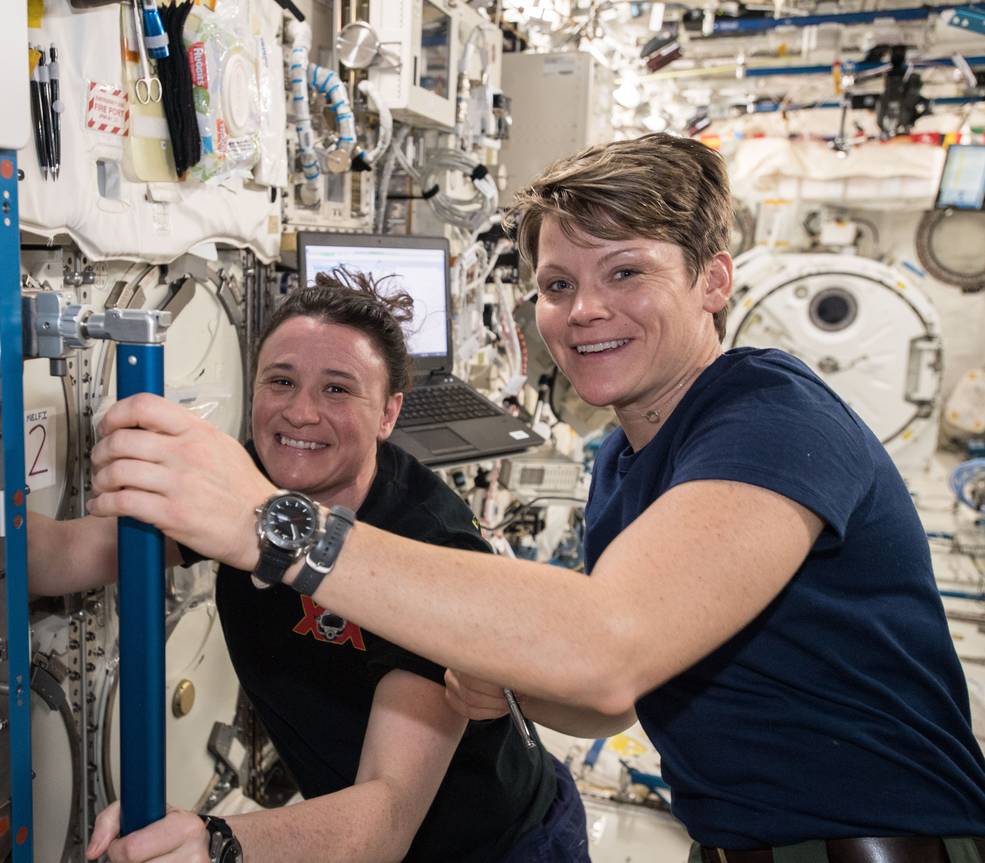
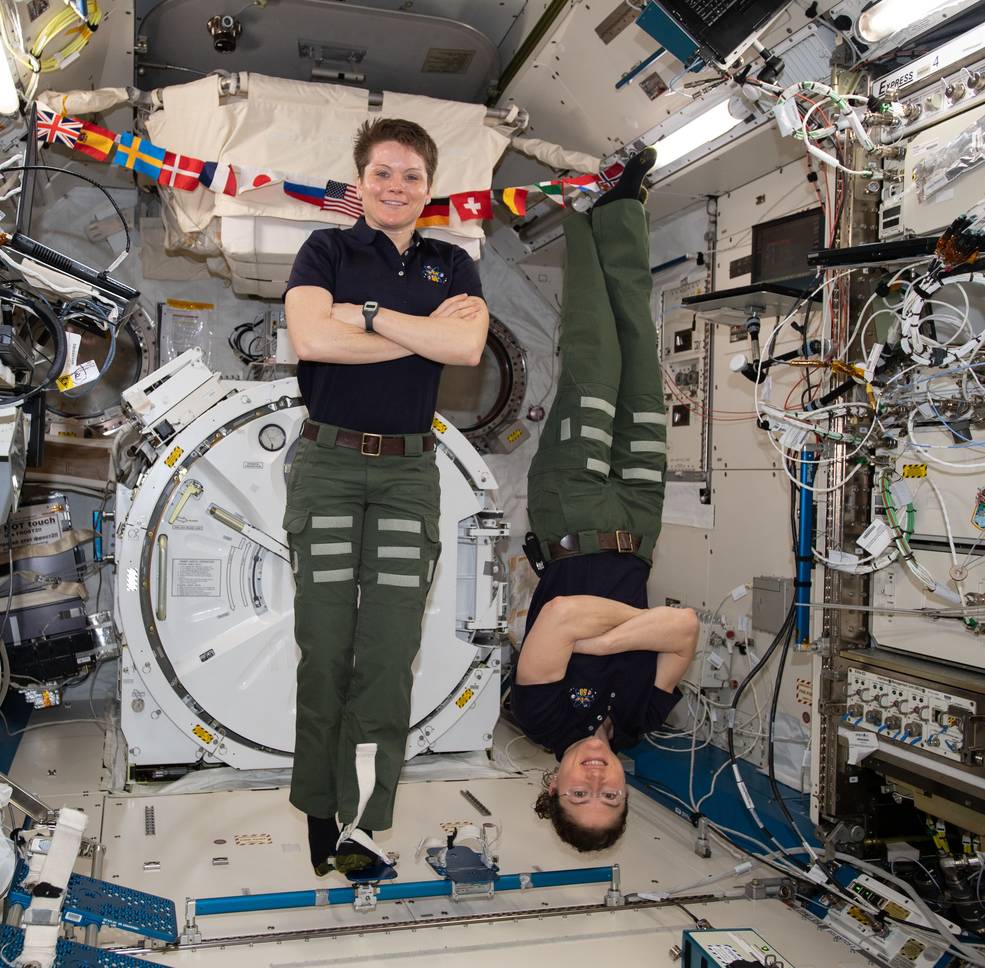
Left: Serena M. Auñón-Chancellor, left, and Anne C. McClain working together in the
Kibo module during Expedition 57. Right: McClain, left, and Christina H. Koch
demonstrating weightlessness during Expedition 59.
The Expedition 61 crew conducted a record nine spacewalks between October 2019 and January 2020. Koch and Meir made history on Oct. 18 when they floated outside the space station to carry out the first all-woman spacewalk, one of several to replace the station’s batteries. The capsule communicator (capcom), the person in the Mission Control Center at NASA’s Johnson Space Center in Houston who communicates with the astronauts in space, for this historic spacewalk was three-time space shuttle veteran Wilson (who as noted above took part in the first four-woman gathering on the space station), assisted by space station veteran Mark T. Vande Hei. “As much as it’s worth celebrating the first spacewalk with an all-female team, I think many of us are looking forward to it just being normal,” astronaut Caldwell Dyson said during live coverage of the spacewalk. As if to prove her point, Koch and Meir conducted two more all-woman spacewalks in January 2020. Meir’s return to Earth marked the end of the longest period to date of a continuous female presence aboard the space station – 682 days from June 8, 2018, to April 17, 2020.
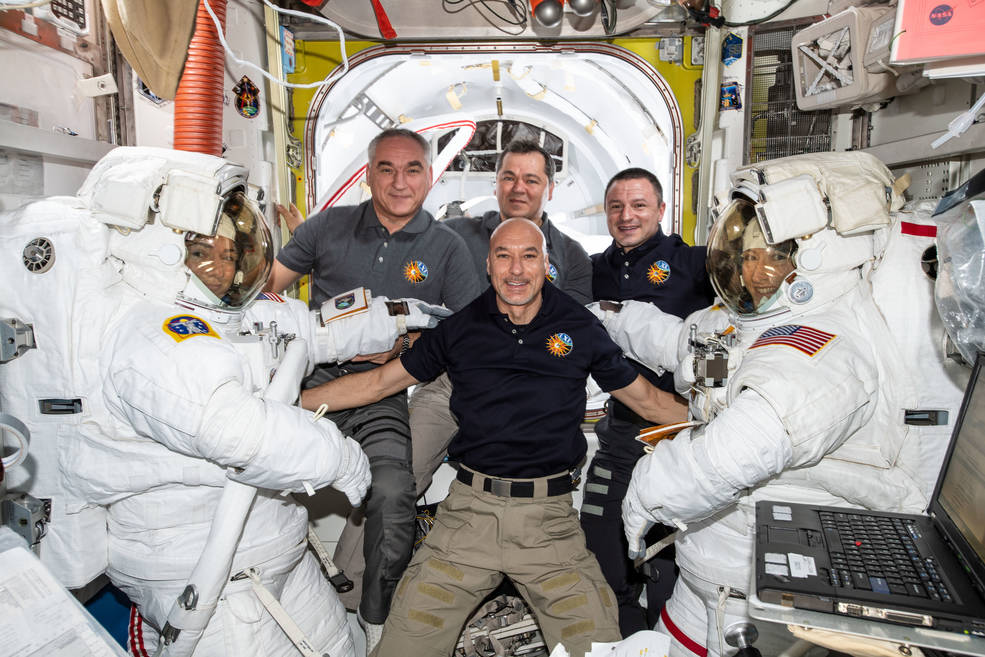
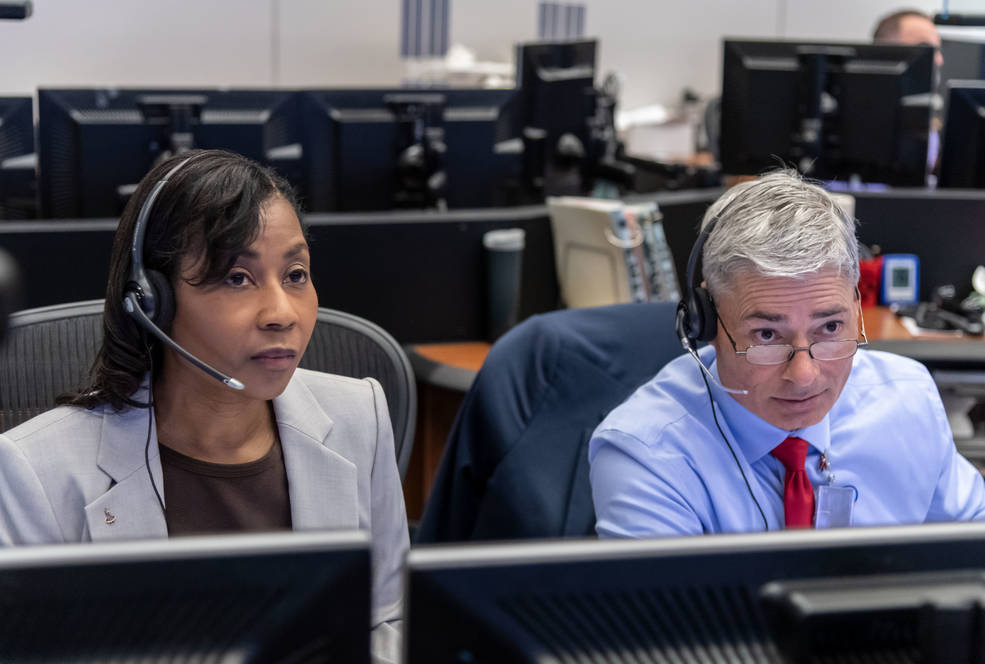
Left: Space suited astronauts Jessica U. Meir, left, and Christina H. Koch, assisted
by their Expedition 61 crewmates, prepare for the first all-woman spacewalk.
Right: Capsule communicators Stephanie D. Wilson, left, and Mark T. Vande Hei
assist Meir and Koch during the first all-woman spacewalk from the Mission
Control Center at NASA’s Johnson Space Center in Houston.
On Nov. 16, 2020, as a member of NASA’s SpaceX Crew-1 mission aboard SpaceX’s Crew Dragon Resilience spacecraft, NASA astronaut Walker became the first woman to travel on a commercial crew vehicle. When she and her three crewmates joined the Expedition 64 crew abord the space station, they comprised the station’s first-ever seven-member resident crew. With NASA astronaut Kathleen H. Rubins already onboard, for the next five months the space station was once again home to two women. K. Megan McArthur followed in April 2021 as pilot of NASA’s SpaceX Crew-2 mission, with Kayla S. Barron aboard the station now as a first time flyer supporting the Crew-3 mission.
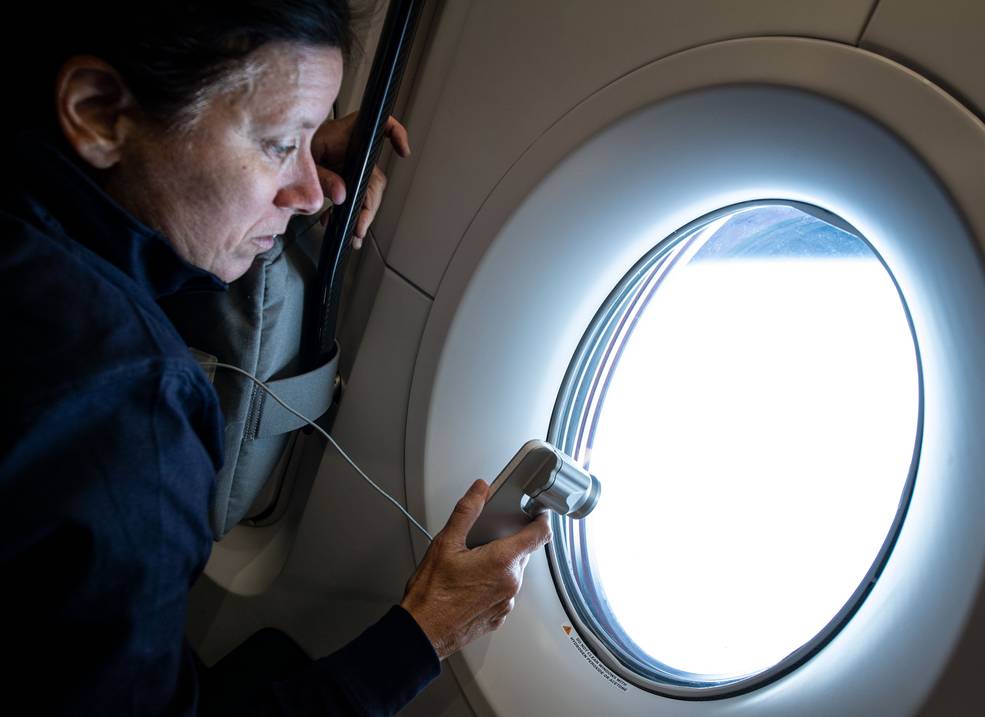
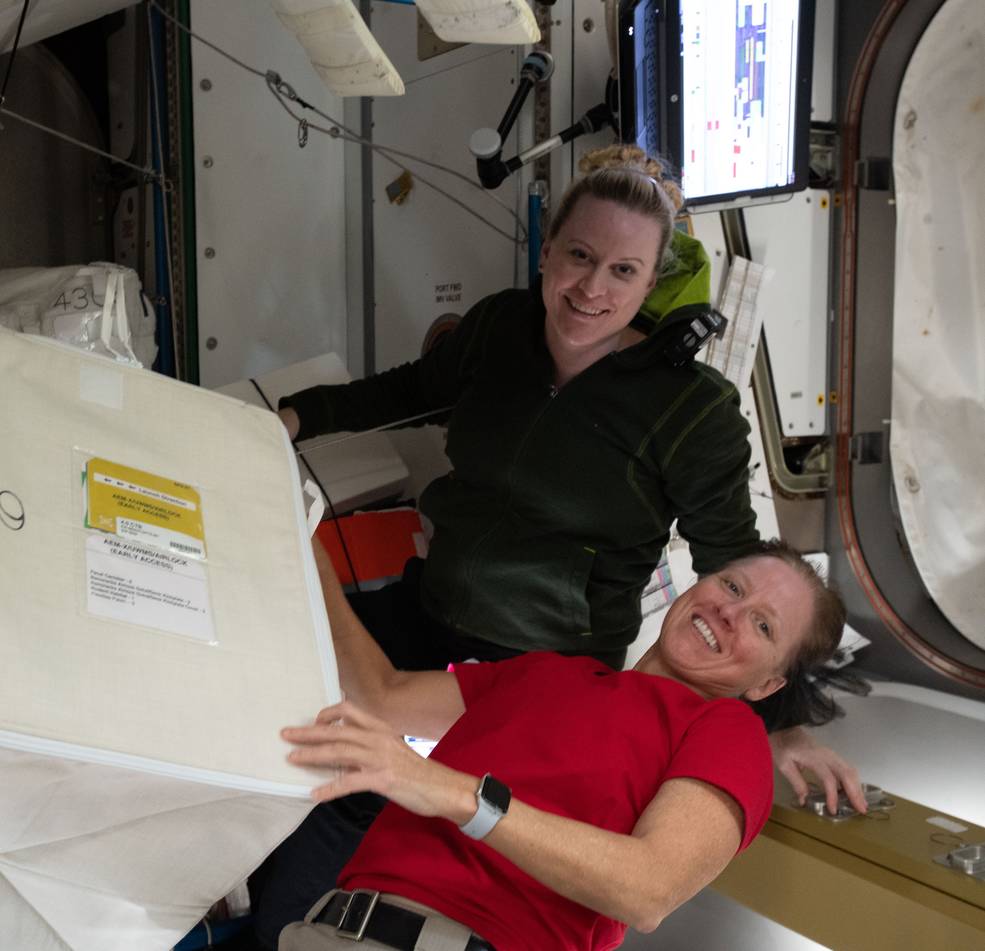
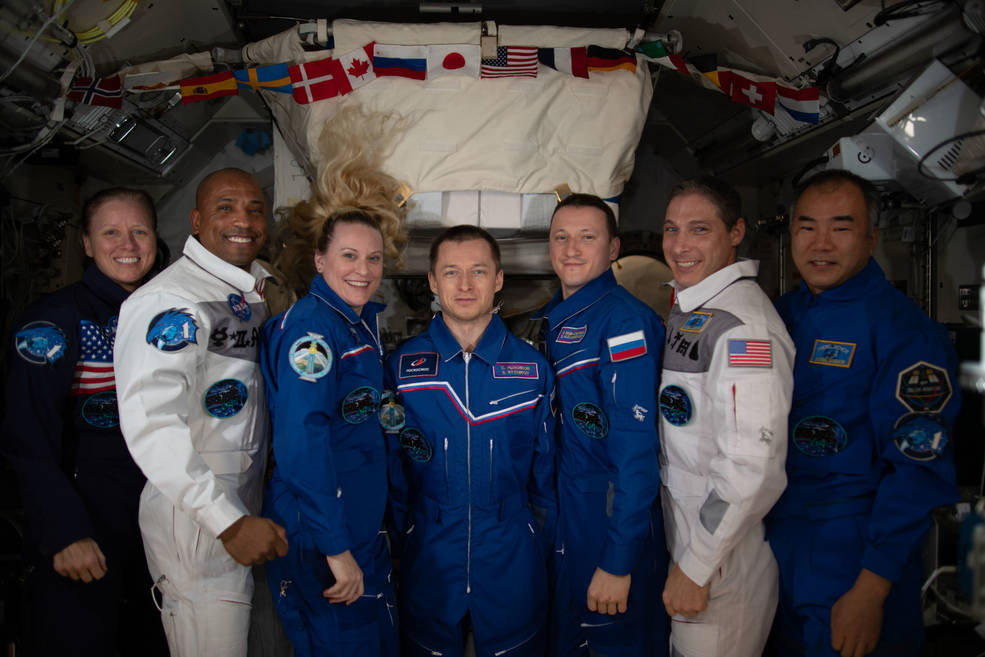
Left: Shannon Walker, the first woman to fly on a commercial crew vehicle, looks out the window of the
SpaceX Crew Dragon spacecraft Resilience. Middle: NASA astronauts Kathleen H. “Kate” Rubins,
left, and Walker working inside the International Space Station. Right: The space station’s first
seven-member crew including Walker, left, and Rubins, third from left, pose in the Kibo module.
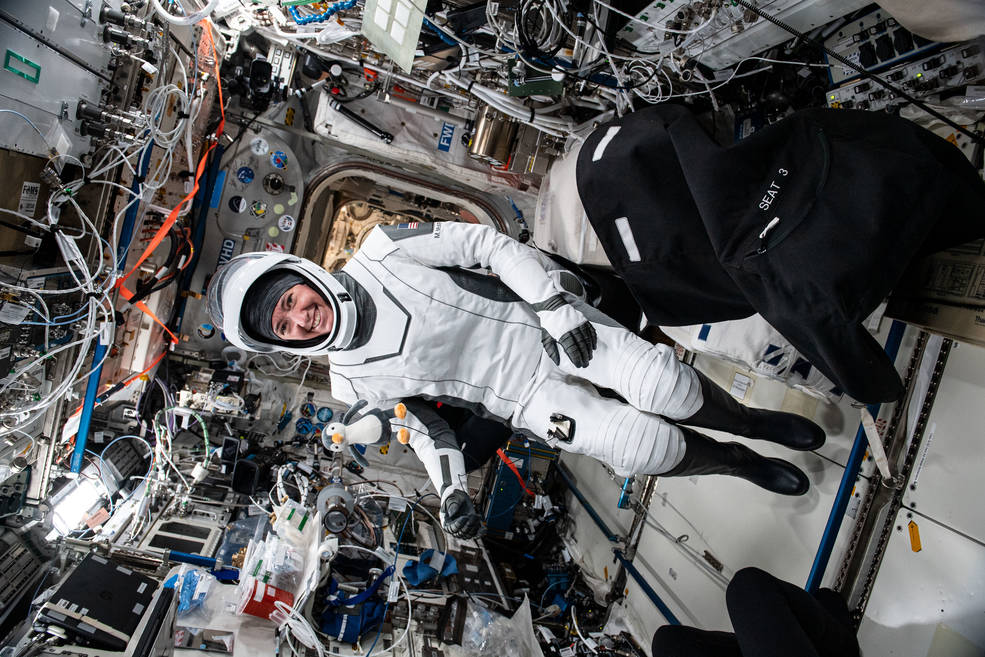
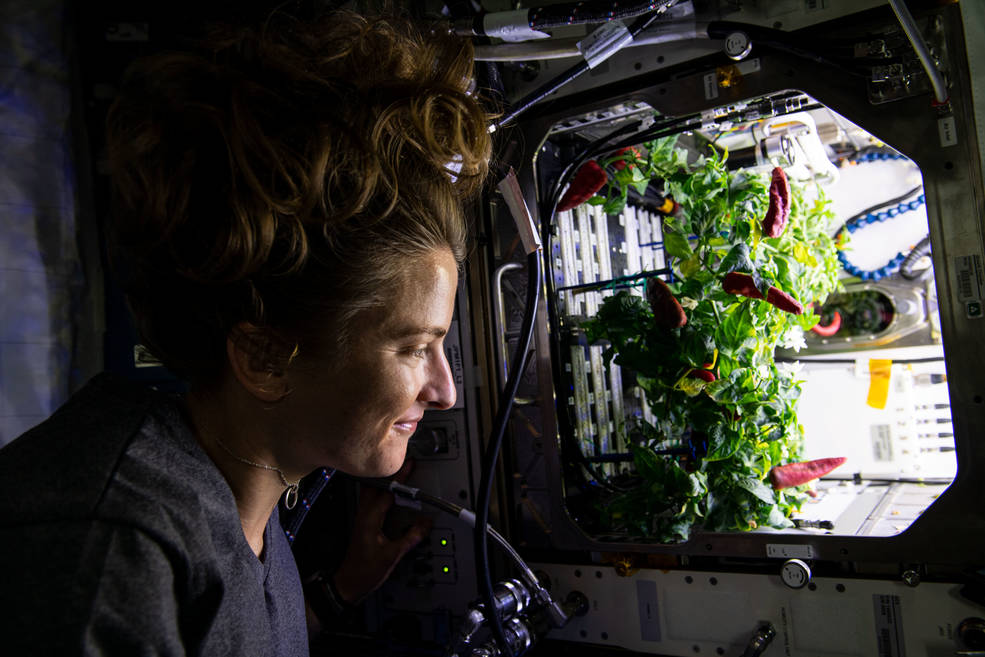
Left: NASA astronaut K. Megan McArthur wearing her SpaceX suit in the Destiny U.S.
Laboratory module in preparation for return to Earth in October 2021. Right: NASA
astronaut Kayla S. Barron inspects chile peppers grown aboard the space station
prior to harvest in November 2021.
Women have been at the forefront of commercial space. In September 2021, two of the four crewmembers of the private space mission Inspiration4 were women – Sian H. Proctor, the first African American woman to pilot a spacecraft, and Hayley Arceneaux. They conducted science experiments during their three-day mission aboard the Crew Dragon Resilience spacecraft. The next month, Russian actress Yulia S. Peresild and her director spent 11 days aboard the space station filming scenes for an upcoming movie entitled “The Challenge.”
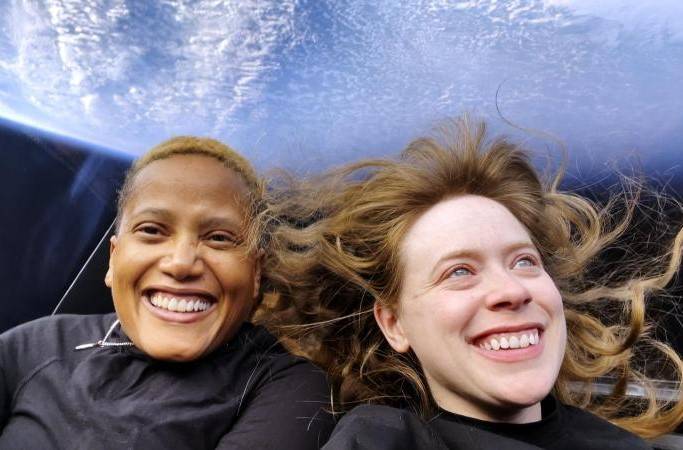
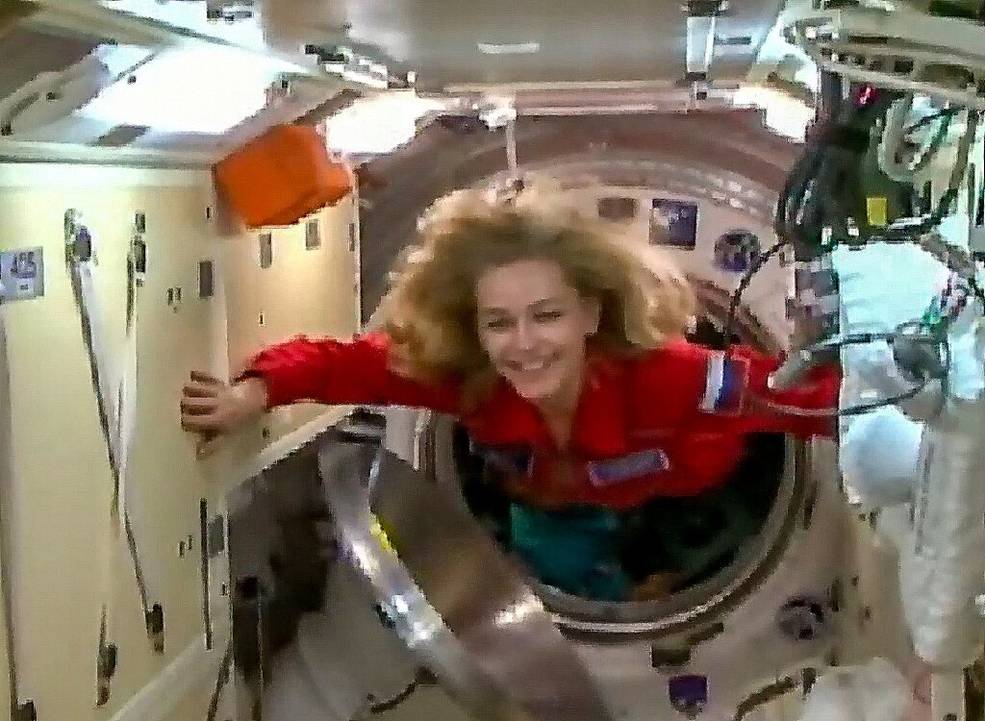
Left: Sian H. Proctor, left, and Hayley Arceneaux during the Inspiration4 private
space mission. Right: Russian actress Yulia S. Peresild arriving at the space station.
The story of women in space would not be complete without mention of the two women from the People’s Republic of China who have flown in space. China’s first female astronaut, Liu Yang, launched on June 16, 2012, aboard the Shenzhou-9 spacecraft with her two crewmates, docking with the Tiangong-1 space station two days later. The trio returned to Earth after a 13-day mission. One year later, on June 11, 2013, Wang Yaping and her two crewmates launched aboard Shenzhou-10 for a 14-day visit to Tiangong-1. She conducted science experiments and taught a live physics lessons to school children from aboard the station. Wang returned to space on Oct. 15, 2021, aboard Shenzhou-13 and is currently on a six-month mission as the first woman to live and work aboard the Chinese Space Station. She also became the first Chinese woman to conduct a spacewalk.



Left: Liu Yang, the People’s Republic of China’s first woman in space, aboard the Tiangong-1
space station. Middle: Wang Yaping teaching a physics lesson live from Tiangong-1.
Right: Wang playing a guzheng in the Tianhe module of the Chinese Space Station.
Image credits: courtesy of CNSA.
An earlier version of this article appeared on March 29, 2021.
To be continued…

